Electric Vehicle-to-Grid (V2G) Technologies: Impact on the Power Grid and Battery
Abstract
1. Introduction
- Detailed revision of V2G system, types, and architecture.
- Overview of the current and future V2G industrial outlook and business models.
- The prospects of V2G for futuristic smart grid and distributed generation.
- Challenges associated with the V2G application on both grid and vehicle sides.
- Highlighting the recent research works and policies to address the challenges with V2G.
- Outlining the research gaps associated with each of the challenges and their present solutions in the literature.
- Power quality and harmonics profile investigation of the V2G technology.
2. Prospects of the V2G System
2.1. V2G Present Scenario and Growth
2.2. V2G Industrial Outlook for Investors and Policymakers
2.3. Electric Mobility-Driven Socio-Environmental Vulnerabilities
3. Electric Vehicle Technology
3.1. Advancement of Electric Vehicle Technologies
3.2. EV Charging Station
- The residential charging station, where the end-user draws the electrical energy. The vehicles–when not in use, especially during night hours–are charged via the wall-mounted indoor outlet;
- The commercial charging station, which is applied to charge the standing vehicles in the parking lots and at public charging places;
- Fast-charging stations (>40 kW), these stations can provide 60 miles of battery backup within 10 to 30 min of charging, which is highly suitable for high-performance EVs;
- Charging stations for zero-emission vehicles (ZEV) can provide 15 min of charging to drive nearly 200 miles. California Air Resources Board (CARB) uses this type to provide credit to non-emissive vehicle users.
3.3. V2G System
3.4. Impact of V2G on the Power System
3.4.1. Improved Power Demand Management
3.4.2. Power Quality Improvement
3.4.3. Regulation of Power Frequency, Reactive Power Injection, and System Voltage
3.4.4. Support for RES
4. Challenges of V2G
4.1. Burden on the Utility Grid
4.2. Increase in System Harmonics
4.3. Battery Lifetime Degradation
4.4. Communication System and Cyber Vulnerability
5. Proposed Solution to Address the V2G Effect
5.1. Proper Grid Load Dispatch with V2G
5.2. System Harmonics Preservation
5.3. Battery Energy Storage Handling
5.4. Communication System and Cyber Vulnerabilities
6. Conclusions
- At present, EVs’ growth is tremendous, leading to a vast opportunity to rationalize V2G technology.
- V2G stands promising to provide ancillary services, such as load shaving, reactive power flow control, system voltage, and frequency fluctuation reduction.
- Among the challenges of V2G implementation, the most crucial part is related to the battery life cycle. A higher magnitude of the charging/discharging cycle of the battery could lead to premature degradation of batteries and reduces the EV drive range.
- Power loss in the power electronics conversation stages and associated harmonics could disturb the grid stability and, thus, needs proper controlling.
- At present, V2G is still immature to marketize. Moreover, there is a lack of a proper business model to commercialize the V2G scheme.
- The current electrical grid, associated electrical machinery, and control strategies need to be revised to check their compatibility to withstand large EV penetration.
- Countries have already begun revising the EV charger standards to enjoy bidirectional power flow. Moreover, top-tier EV manufacturing farms have joined across the border to initiate proper business models and technological maturity for V2G implementation.
Author Contributions
Funding
Acknowledgments
Conflicts of Interest
Nomenclature
| EV | Electric Vehicle | DSRC | Dedicated Short Range Communication |
| V2G | Vehicle-to-Grid | SUKA | Secure User Key-exchange Authentication |
| PV | Photovoltaic | RBO | Regenerative Braking Operation |
| BEV | Battery Electric Vehicle | EVCS | Electric Vehicle Charging Station |
| CPS | Cyber Physical System | LCV | Low Commercial Vehicle |
| SEV | Solar Electric Vehicle | HRS | Hydrogen Refueling Station |
| PEV | Plug-in Electric Vehicle | IEA | International Energy Agency |
| V2V | Vehicle-to-Vehicle | REEV | Range Extended Electric Vehicle |
| V2H | Vehicle-to-Home | EVSE | Electric Vehicle Supply Equipment |
| V2G | Vehicle-to-Grid | FPGA | Field Programmable Gate Array |
| CEM | Clean Energy Ministerial | CARB | California Air Resources Board |
| R&D | Research and Development | WEVCS | Wireless Electric Vehicle Charging Station |
| EDF | Électricité de France | IWCS | Inductive Wireless Charging Station |
| WTW | Well to Wheel | CWCS | Capacitive Wireless Charging Station |
| OBC | Onboard Charger | PMWCS | Permanent Magnet-gear Wireless Charging Station |
| BMS | Battery Management System | RIWCS | Resonant Inductive Wireless Charging Station |
| RPM | Revolution per Minute | IRENA | International Renewable Energy Agency |
| WTT | Well to Tank | ICE | Internal Combustion Engines |
| FCEV | Fuel Cell Electric Vehicle | MILF | Mixed Integer Linear Programming |
| PCC | Point of Common Coupling | HEMS | Home Energy Management System |
| EVM | Electric Vehicle Management | STATCOM | Static Synchronous Compensator |
| EMS | Energy Management System | DER | Distributed Energy Resource |
| APF | Active Power Filter | ISO | Independent System Operator |
| AI | Artificial Intelligence | TLS | Transport Layer Security |
| IoT | Internet of Things | UA | Unilateral Authentication |
| ZEV | Zero Emission Vehicle | RTO | Regional Transmission Organization |
| ToU | Time of Use | LSTM | Long Short Term Memory |
| AO | Aggregator Operator | CES | Corporate Energy System |
| EMU | Energy Management Unit | PWM | Pulse Width Modulation |
| VSC | Voltage Source Converter | IGBT | Insulated Gate Bipolar Transistor |
| G2V | Grid to Vehicle | PHEV | Plug-in Hybrid Electric Vehicle |
| TDD | Total Demand Distortion | BESS | Battery Energy Storage System |
| VOC | Voltage Oriented Control | EMI | Energy Metering Infrastructure |
| SoC | State of Charge | PMSM | Permanent Magnet Synchronous Machine |
| DoD | Depth of Discharge | SRM | Synchronous Reluctance Machine |
| UC | Ultra-capacitor | SWFM | Synchronous Wound Field Machine |
| PUF | Physical Unclonable Function | NREL | National Renewable Energy Lab |
| THD | Total Harmonic Distortion | HVAC | Heating, Ventilation, Air Conditioning |
| OBC | Onboard Battery Charger | EVTMCS | Electric Vehicle Thermal Management Control System |
| MMF | Magnetomotive Force | HESS | Hybrid Energy Storage System |
References
- Corchero, C. Managing Grid Integration of Electric Vehicles GEF Global Programme to Support Countries with the Shift to Electric Mobility. 2022. Available online: https://www.iea.org/events/managing-grid-integration-of-electric-vehicles (accessed on 20 September 2022).
- IRENA. Insights on Renewables-Dataset. 2021. Available online: https://www.irena.org/publications/2021/March/Renewable-Capacity-Statistics-2021 (accessed on 20 September 2022).
- IRENA. Trends in Renewable Energy by Region-Dataset. 2021. Available online: https://www.irena.org/publications/2021/Aug/Renewable-energy-statistics-2021 (accessed on 20 September 2022).
- IRENA. Power System Flexibility for the Energy Transition-Report. 2018. Available online: https://www.irena.org/publications (accessed on 20 September 2022).
- IEA. Global Electric Vehicle Stock by Transport Mode, 2010–2020-Report. 2021. Available online: https://www.iea.org/data-and-statistics/charts/global-electric-vehicle-stock-by-transport-mode-2010-2020 (accessed on 20 September 2022).
- IEA. Global EV Outlook 2019. 2019. Available online: https://www.iea.org/reports/global-ev-outlook-2019 (accessed on 20 September 2022).
- Flores, R.J.; Shaffer, B.P.; Brouwer, J. Electricity costs for an electric vehicle fueling station with Level 3 charging. Appl. Energy 2016, 169, 813–830. [Google Scholar] [CrossRef]
- Li, Y.; Davis, C.; Lukszo, Z.; Weijnen, M. Electric vehicle charging in China’s power system: Energy, economic and environmental trade-offs and policy implications. Appl. Energy 2016, 173, 535–554. [Google Scholar] [CrossRef]
- NREL. Average Range vs Efficiency of US Electric Vehicles. 2021. Available online: https://afdc.energy.gov/data/10963 (accessed on 20 September 2022).
- Kosai, S.; Zakaria, S.; Che, H.S.; Hasanuzzaman, M.; Rahim, N.A.; Tan, C.; Ahmad, R.D.R.; Abbas, A.R.; Nakano, K.; Yamasue, E.; et al. Estimation of Greenhouse Gas Emissions of Petrol, Biodiesel and Battery Electric Vehicles in Malaysia Based on Life Cycle Approach. Sustainability 2022, 14, 5783. [Google Scholar] [CrossRef]
- IEA. Global EV Outlook 2018. 2018. Available online: https://www.iea.org/reports/global-ev-outlook-2018 (accessed on 20 September 2022).
- Green, R.C.; Wang, L.; Alam, M. The impact of plug-in hybrid electric vehicles on distribution networks: A review and outlook. Renew. Sustain. Energy Rev. 2011, 15, 544–553. [Google Scholar] [CrossRef]
- Zheng, Y.; Niu, S.; Shang, Y.; Shao, Z.; Jian, L. Integrating plug-in electric vehicles into power grids: A comprehensive review on power interaction mode, scheduling methodology and mathematical foundation. Renew. Sustain. Energy Rev. 2019, 112, 424–439. [Google Scholar] [CrossRef]
- Zheng, Y.; Shang, Y.; Shao, Z.; Jian, L. A novel real-time scheduling strategy with near-linear complexity for integrating large-scale electric vehicles into smart grid. Appl. Energy 2018, 217, 1–13. [Google Scholar] [CrossRef]
- CEM. EV30@30, Increasing Uptake of Electric Vehicles. 2020. Available online: https://www.iea.org/news/new-cem-campaign-aims-for-goal-of-30-new-electric-vehicle-sales-by-2030 (accessed on 20 September 2022).
- NEF, B. BNEF EVO Report 2020. 2020. Available online: https://about.bnef.com/electric-vehicle-outlook/ (accessed on 20 September 2022).
- IEA. Global EV Outlook 2021. 2021. Available online: https://www.iea.org/reports/global-ev-outlook-2021 (accessed on 20 September 2022).
- Sovacool, B.K.; Kester, J.; Noel, L.; de Rubens, G.Z. Income, political affiliation, urbanism and geography in stated preferences for electric vehicles (EVs) and vehicle-to-grid (V2G) technologies in Northern Europe. J. Transp. Geogr. 2019, 78, 214–229. [Google Scholar] [CrossRef]
- IEA. Global EV Outlook 2020. 2020. Available online: https://www.iea.org/reports/global-ev-outlook-2020 (accessed on 20 September 2022).
- IEA. Global EV Data Explorer. 2021. Available online: https://www.iea.org/articles/global-ev-data-explorer (accessed on 20 September 2022).
- IEA. Vehicle-to-Grid Potential and Variable Renewable Capacity Relative to Total Capacity Generation Requirements in the Sustainable Development Scenario, 2030. 2020. Available online: https://www.iea.org/data-and-statistics/charts/vehicle-to-grid-potential (accessed on 20 September 2022).
- IEA. Electric Cars Fend off Supply Challenges to More than Double Global Sales. 2022. Available online: https://www.iea.org/commentaries/electric-cars-fend-off-supply-challenges-to-more-than-double-global-sales (accessed on 20 September 2022).
- IEA. Global Electric Car Stock, 2010–2021. 2022. Available online: https://www.iea.org/data-and-statistics/charts/global-electric-car-stock-2010-2021 (accessed on 20 September 2022).
- Kester, J.; Noel, L.; Zarazua de Rubens, G.; Sovacool, B.K. Promoting Vehicle to Grid (V2G) in the Nordic region: Expert advice on policy mechanisms for accelerated diffusion. Energy Policy 2018, 116, 422–432. [Google Scholar] [CrossRef]
- Dernai, M. Premium Meets Responsibility-Sustainability across the Entire Value Chain. 2022. Available online: https://www.iea.org/reports/clean-energy-innovation/innovation-needs-in-the-sustainable-development-scenario (accessed on 20 September 2022).
- IEA. Global EV Policy Explorer. 2021. Available online: https://www.iea.org/articles/global-ev-policy-explorer (accessed on 20 September 2022).
- Sovacool, B.K.; Kester, J.; Noel, L.; de Rubens, G.Z. Energy Injustice and Nordic Electric Mobility: Inequality, Elitism, and Externalities in the Electrification of Vehicle-to-Grid (V2G) Transport. Ecol. Econ. 2019, 157, 205–217. [Google Scholar] [CrossRef]
- Verlinghieri, E.; Venturini, F. Exploring the right to mobility through the 2013 mobilizations in Rio de Janeiro. J. Transp. Geogr. 2018, 67, 126–136. [Google Scholar] [CrossRef]
- Gopal, A.R.; Park, W.Y.; Witt, M.; Phadke, A. Hybrid- and battery-electric vehicles offer low-cost climate benefits in China. Transp. Res. Part D Transp. Environ. 2018, 62, 362–371. [Google Scholar] [CrossRef]
- Onat, N.C.; Kucukvar, M.; Tatari, O. Conventional, hybrid, plug-in hybrid or electric vehicles? State-based comparative carbon and energy footprint analysis in the United States. Appl. Energy 2015, 150, 36–49. [Google Scholar] [CrossRef]
- Krause, J.; Thiel, C.; Tsokolis, D.; Samaras, Z.; Rota, C.; Ward, A.; Prenninger, P.; Coosemans, T.; Neugebauer, S.; Verhoeve, W. EU road vehicle energy consumption and CO2 emissions by 2050–Expert-based scenarios. Energy Policy 2020, 138, 111224. [Google Scholar] [CrossRef]
- Kim, T.S.; Manzie, C.; Watson, H. Fuel Economy Benefits of Look-ahead Capability in a Mild Hybrid Configuration. IFAC Proc. Vol. 2008, 41, 5646–5651. [Google Scholar] [CrossRef]
- Cardoso, D.S.; Fael, P.O.; Espírito-Santo, A. A review of micro and mild hybrid systems. Energy Rep. 2020, 6, 385–390. [Google Scholar] [CrossRef]
- Buekers, J.; Van Holderbeke, M.; Bierkens, J.; Int Panis, L. Health and environmental benefits related to electric vehicle introduction in EU countries. Transp. Res. Part D: Transp. Environ. 2014, 33, 26–38. [Google Scholar] [CrossRef]
- Igbinovia, F.; Fandi, G.; Mahmoud, R.; Tlustý, J. A Review of Electric Vehicles Emissions and its Smart Charging Techniques Influence on Power Distribution Grid. J. Eng. Sci. Technol. Rev. 2016, 9, 80–85. [Google Scholar] [CrossRef]
- Zahedmanesh, A.; Muttaqi, K.M.; Sutanto, D. Direct Control of Plug-In Electric Vehicle Charging Load Using an In-House Developed Intermediate Control Unit. IEEE Trans. Ind. Appl. 2019, 55, 2208–2218. [Google Scholar] [CrossRef]
- Young, K.; Wang, C.; Wang, L.Y.; Strunz, K. Electric Vehicle Battery Technologies. In Electric Vehicle Integration into Modern Power Networks; Garcia-Valle, R., Peças Lopes, J.A., Eds.; Springer: New York, NY, USA, 2013; pp. 15–56. [Google Scholar]
- Goetzel, N.; Hasanuzzaman, M. An empirical analysis of electric vehicle cost trends: A case study in Germany. Res. Transp. Bus. Manag. 2022, 43, 100825. [Google Scholar] [CrossRef]
- Li, S.G.; Sharkh, S.M.; Walsh, F.C.; Zhang, C.N. Energy and Battery Management of a Plug-In Series Hybrid Electric Vehicle Using Fuzzy Logic. IEEE Trans. Veh. Technol. 2011, 60, 3571–3585. [Google Scholar] [CrossRef]
- Tang, Z.; Li, X. Gear Ratio Distribution of Electric Vehicle Reducer. J. Phys. Conf. Ser. 2020, 1654, 012011. [Google Scholar] [CrossRef]
- Yuan, X.; Li, L.; Gou, H.; Dong, T. Energy and environmental impact of battery electric vehicle range in China. Appl. Energy 2015, 157, 75–84. [Google Scholar] [CrossRef]
- Alsharif, A.; Tan, C.W.; Ayop, R.; Dobi, A.; Lau, K.Y. A comprehensive review of energy management strategy in Vehicle-to-Grid technology integrated with renewable energy sources. Sustain. Energy Technol. Assess. 2021, 47, 101439. [Google Scholar] [CrossRef]
- Dik, A.; Omer, S.; Boukhanouf, R. Electric Vehicles: V2G for Rapid, Safe, and Green EV Penetration. Energies 2022, 15, 803. [Google Scholar] [CrossRef]
- Chandra Mouli, G.R.; Bauer, P.; Zeman, M. System design for a solar powered electric vehicle charging station for workplaces. Appl. Energy 2016, 168, 434–443. [Google Scholar] [CrossRef]
- Farahmand, M.Z.; Javadi, S.; Sadati, S.M.; Laaksonen, H.; Shafie-khah, M. Optimal Operation of Solar Powered Electric Vehicle Parking Lots Considering Different Photovoltaic Technologies. Clean Technol. 2021, 3, 30. [Google Scholar] [CrossRef]
- Fathabadi, H. Utilizing solar and wind energy in plug-in hybrid electric vehicles. Energy Convers. Manag. 2018, 156, 317–328. [Google Scholar] [CrossRef]
- Lovatt, H.C.; Ramsden, V.S.; Mecrow, B.C. Design of an in-wheel motor for a solar-powered electric vehicle. IEE Proc. -Electr. Power Appl. 1998, 145, 402–408. [Google Scholar] [CrossRef]
- Mahmoudi, C.; Flah, A.; Sbita, L. An overview of electric Vehicle concept and power management strategies. In Proceedings of the 2014 International Conference on Electrical Sciences and Technologies in Maghreb (CISTEM), Tunis, Tunisia, 3–6 November 2014; pp. 1–8. [Google Scholar]
- Bilgin, B.; Magne, P.; Malysz, P.; Yang, Y.; Pantelic, V.; Preindl, M.; Korobkine, A.; Jiang, W.; Lawford, M.; Emadi, A. Making the Case for Electrified Transportation. IEEE Trans. Transp. Electrif. 2015, 1, 4–17. [Google Scholar] [CrossRef]
- Choi, M.; Lee, J.; Seo, S. Real-Time Optimization for Power Management Systems of a Battery/Supercapacitor Hybrid Energy Storage System in Electric Vehicles. IEEE Trans. Veh. Technol. 2014, 63, 3600–3611. [Google Scholar] [CrossRef]
- Åhman, M. Government policy and the development of electric vehicles in Japan. Energy Policy 2006, 34, 433–443. [Google Scholar] [CrossRef]
- Sanguesa, J.A.; Torres-Sanz, V.; Garrido, P.; Martinez, F.J.; Marquez-Barja, J.M. A Review on Electric Vehicles: Technologies and Challenges. Smart Cities 2021, 4, 372–404. [Google Scholar] [CrossRef]
- Kang, N.; Ren, Y.; Feinberg, F.M.; Papalambros, P.Y. Public investment and electric vehicle design: A model-based market analysis framework with application to a USA–China comparison study. Des. Sci. 2016, 2, e6. [Google Scholar] [CrossRef]
- International, S. Vehicle Architecture for Data Communications Standards—Class B Data Communications Network Interface; SAE International: Warrendale, PA, USA, 2009. [Google Scholar]
- GB/T. Connection Set for Conductive Charging of Electric Vehicles—Part 1: General Requirements. 2015. Available online: https://www.cec.org.cn/upload/1/editor/1649832337218.pdf (accessed on 20 September 2022).
- IEC. Plugs, Socket-Outlets, Vehicle Couplers and Vehicle Inlets-Conductive Charging of Electric Vehicles-Part 1: General Requirements; IEC: Geneva, Switzerland, 2014; Available online: https://webstore.iec.ch/publication/59922 (accessed on 20 September 2022).
- IEC. Electric Vehicle Conductive Charging System-Part 1: General Requirements; IEC: Geneva, Switzerland, 2017; Available online: https://webstore.ansi.org/Standards/IEC/iec61851ed2017 (accessed on 20 September 2022).
- IEC. Plugs, Socket-Outlets, Vehicle Connectors and Vehicle Inlets-Conductive Charging of Electric Vehicles-Part 2: Dimensional Compatibility and Interchangeability Requirements for a.c. pin and Contact-Tube Accessories; IEC: Geneva, Switzerland, 2016; Available online: https://webstore.iec.ch/publication/6582 (accessed on 20 September 2022).
- Bi, Z.; Kan, T.; Mi, C.C.; Zhang, Y.; Zhao, Z.; Keoleian, G.A. A review of wireless power transfer for electric vehicles: Prospects to enhance sustainable mobility. Appl. Energy 2016, 179, 413–425. [Google Scholar] [CrossRef]
- Islam, F.R.; Pota, H.R. Plug-in-hybrid electric vehicles park as virtual DVR. Electron. Lett. 2013, 49, 211–213. [Google Scholar] [CrossRef]
- Sripad, S.; Kulandaivel, S.; Pande, V.; Sekar, V.; Viswanathan, V. Vulnerabilities of Electric Vehicle Battery Packs to Cyberattacks on Auxiliary Components. 2017. Available online: https://arxiv.org/abs/1711.04822 (accessed on 20 September 2022).
- Corrigan, D.; Menjak, I.; Cleto, B.; Dhar, S.; Ovshinsky, S.; Frank, A. Nickel-Metal Hydride Batteries For ZEV-Range Hybrid Electric Vehicles; University of California: Davis, CA, USA, 2022. [Google Scholar]
- DOT, U. Electric Vehicle Charging Speeds. Available online: https://www.transportation.gov/rural/ev/toolkit/ev-basics/charging-speeds (accessed on 20 September 2022).
- Das, H.S.; Tan, C.W.; Yatim, A.H.M. Fuel cell hybrid electric vehicles: A review on power conditioning units and topologies. Renew. Sustain. Energy Rev. 2017, 76, 268–291. [Google Scholar] [CrossRef]
- Wishart, J. Fuel cells vs Batteries in the Automotive Sector. 2014. Available online: https://www.researchgate.net/profile/Jeffrey-Wishart/publication/311210193_Fuel_cells_vs_Batteries_in_the_Automotive_Sector/links/583f628808ae8e63e6182d34/Fuel-cells-vs-Batteries-in-the-Automotive-Sector.pdf (accessed on 20 September 2022).
- Patt, A.; Pfenninger, S.; Lilliestam, J. Vulnerability of solar energy infrastructure and output to climate change. Clim. Change 2013, 121, 93–102. [Google Scholar] [CrossRef]
- Dai, J.; Ludois, D.C. Wireless electric vehicle charging via capacitive power transfer through a conformal bumper. In Proceedings of the 2015 IEEE Applied Power Electronics Conference and Exposition (APEC), Charlotte, NC, USA, 15–19 March 2015; pp. 3307–3313. [Google Scholar]
- Kline, M.; Izyumin, I.; Boser, B.; Sanders, S. Capacitive power transfer for contactless charging. In Proceedings of the 2011 Twenty-Sixth Annual IEEE Applied Power Electronics Conference and Exposition (APEC), Fort Worth, TX, USA, 6–11 March 2011; pp. 1398–1404. [Google Scholar]
- Machura, P.; Li, Q. A critical review on wireless charging for electric vehicles. Renew. Sustain. Energy Rev. 2019, 104, 209–234. [Google Scholar] [CrossRef]
- Panchal, C.; Stegen, S.; Lu, J. Review of static and dynamic wireless electric vehicle charging system. Eng. Sci. Technol. Int. J. 2018, 21, 922–937. [Google Scholar] [CrossRef]
- Islam, F.R.; Cirrincione, M. Vehicle to grid system to design a centre node virtual unified power flow controller. Electron. Lett. 2016, 52, 1330–1332. [Google Scholar] [CrossRef]
- Mendoza-Araya, P.A.; Kollmeyer, P.J.; Ludois, D.C. V2G integration and experimental demonstration on a lab-scale microgrid. In Proceedings of the 2013 IEEE Energy Conversion Congress and Exposition, Denver, CO, USA, 15–19 September 2013; pp. 5165–5172. [Google Scholar]
- Ravi, S.S.; Aziz, M. Utilization of Electric Vehicles for Vehicle-to-Grid Services: Progress and Perspectives. Energies 2022, 15, 589. [Google Scholar] [CrossRef]
- Hoang, D.T.; Wang, P.; Niyato, D.; Hossain, E. Charging and Discharging of Plug-In Electric Vehicles (PEVs) in Vehicle-to-Grid (V2G) Systems: A Cyber Insurance-Based Model. IEEE Access 2017, 5, 732–754. [Google Scholar] [CrossRef]
- Ahn, C.; Li, C.-T.; Peng, H. Optimal decentralized charging control algorithm for electrified vehicles connected to smart grid. J. Power Sources 2011, 196, 10369–10379. [Google Scholar] [CrossRef]
- Habib, S.; Khan, M.M.; Abbas, F.; Tang, H. Assessment of electric vehicles concerning impacts, charging infrastructure with unidirectional and bidirectional chargers, and power flow comparisons. Int. J. Energy Res. 2018, 42, 3416–3441. [Google Scholar] [CrossRef]
- Guille, C.; Gross, G. A conceptual framework for the vehicle-to-grid (V2G) implementation. Energy Policy 2009, 37, 4379–4390. [Google Scholar] [CrossRef]
- Sortomme, E.; El-Sharkawi, M.A. Optimal Charging Strategies for Unidirectional Vehicle-to-Grid. IEEE Trans. Smart Grid 2011, 2, 131–138. [Google Scholar] [CrossRef]
- Sousa, T.; Morais, H.; Soares, J.; Vale, Z. Day-ahead resource scheduling in smart grids considering Vehicle-to-Grid and network constraints. Appl. Energy 2012, 96, 183–193. [Google Scholar] [CrossRef]
- Dogger, J.D.; Roossien, B.; Nieuwenhout, F.D.J. Characterization of Li-Ion Batteries for Intelligent Management of Distributed Grid-Connected Storage. IEEE Trans. Energy Convers. 2011, 26, 256–263. [Google Scholar] [CrossRef]
- Akhade, P.; Moghaddami, M.; Moghadasi, A.; Sarwat, A. A Review on Control Strategies for Integration of Electric Vehicles with Power Systems. In Proceedings of the 2018 IEEE/PES Transmission and Distribution Conference and Exposition (T&D), Denver, CO, USA, 16–19 April 2018; pp. 1–5. [Google Scholar]
- Krivchenkov, A.; Saltanovs, R. Analysis of wireless communications for V2G applications using WPT technology in energy transfer to mobile objects. In Proceedings of the 2015 56th International Scientific Conference on Power and Electrical Engineering of Riga Technical University (RTUCON), Riga, Latvia, 14 October 2015; pp. 1–4. [Google Scholar]
- Casaleiro, Â.; Amaro e Silva, R.; Teixeira, B.; Serra, J.M. Experimental assessment and model validation of power quality parameters for vehicle-to-grid systems. Electr. Power Syst. Res. 2021, 191, 106891. [Google Scholar] [CrossRef]
- Deilami, S.; Masoum, A.S.; Moses, P.S.; Masoum, M.A.S. Real-Time Coordination of Plug-In Electric Vehicle Charging in Smart Grids to Minimize Power Losses and Improve Voltage Profile. IEEE Trans. Smart Grid 2011, 2, 456–467. [Google Scholar] [CrossRef]
- Xu, D.Q.; Joós, G.; Lévesque, M.; Maier, M. Integrated V2G, G2V, and Renewable Energy Sources Coordination Over a Converged Fiber-Wireless Broadband Access Network. IEEE Trans. Smart Grid 2013, 4, 1381–1390. [Google Scholar] [CrossRef]
- Fahad, M.; Beenish, H. Efficient V2G Model on Smart Grid Power Systems Using Genetic Algorithm. In Proceedings of the 2019 1st Global Power, Energy and Communication Conference (GPECOM), Nevsehir, Turkey, 12–15 June 2019; pp. 445–450. [Google Scholar]
- Zengquan, Y.; Haiping, X.; Huachun, H.; Yingjie, Z. Research of bi-directional smart metering system for EV charging station based on ZigBee communication. In Proceedings of the 2014 IEEE Conference and Expo Transportation Electrification Asia-Pacific (ITEC Asia-Pacific), Beijing, China, 31 August–3 September 2014; pp. 1–5. [Google Scholar]
- Mwasilu, F.; Justo, J.J.; Kim, E.-K.; Do, T.D.; Jung, J.-W. Electric vehicles and smart grid interaction: A review on vehicle to grid and renewable energy sources integration. Renew. Sustain. Energy Rev. 2014, 34, 501–516. [Google Scholar] [CrossRef]
- Fan, X.; Liu, B.; Liu, J.; Ding, J.; Han, X.; Deng, Y.; Lv, X.; Xie, Y.; Chen, B.; Hu, W.; et al. Battery Technologies for Grid-Level Large-Scale Electrical Energy Storage. Trans. Tianjin Univ. 2020, 26, 92–103. [Google Scholar] [CrossRef]
- Yuan, J.; Dorn-Gomba, L.; Callegaro, A.D.; Reimers, J.; Emadi, A. A Review of Bidirectional On-Board Chargers for Electric Vehicles. IEEE Access 2021, 9, 51501–51518. [Google Scholar] [CrossRef]
- EV Compare. All Electric Passenger Cars. Available online: https://evcompare.io/cars/ (accessed on 20 September 2022).
- Driven, T. EV Models. Available online: https://thedriven.io/ev-models/ (accessed on 20 September 2022).
- Heydt, G.T. The Impact of Electric Vehicle Deployment on Load Management Straregies. IEEE Trans. Power Appar. Syst. 1983, PAS-102, 1253–1259. [Google Scholar] [CrossRef]
- Denholm, P.; Ela, E.; Kirby, B.; Milligan, M. Role of Energy Storage with Renewable Electricity Generation; NREL: Golden, CO, USA, 2010. [Google Scholar]
- Mahmud, K.; Morsalin, S.; Kafle, Y.R.; Town, G.E. Improved peak shaving in grid-connected domestic power systems combining photovoltaic generation, battery storage, and V2G-capable electric vehicle. In Proceedings of the 2016 IEEE International Conference on Power System Technology (POWERCON), Wollongong, Australia, 28 September–1 October 2016; pp. 1–4. [Google Scholar]
- Shumei, C.; Xiaofei, L.; Dewen, T.; Qianfan, Z.; Liwei, S. The construction and simulation of V2G system in micro-grid. In Proceedings of the 2011 International Conference on Electrical Machines and Systems, Beijing, China, 20–23 August 2011; pp. 1–4. [Google Scholar]
- Datta, U.; Saiprasad, N.; Kalam, A.; Shi, J.; Zayegh, A. A price-regulated electric vehicle charge-discharge strategy for G2V, V2H, and V2G. Int. J. Energy Res. 2019, 43, 1032–1042. [Google Scholar] [CrossRef]
- Salvatti, G.A.; Carati, E.G.; Cardoso, R.; da Costa, J.P.; Stein, C.M. Electric Vehicles Energy Management with V2G/G2V Multifactor Optimization of Smart Grids. Energies 2020, 13, 1191. [Google Scholar] [CrossRef]
- Onishi, V.C.; Antunes, C.H.; Trovão, J.P. Optimal Energy and Reserve Market Management in Renewable Microgrid-PEVs Parking Lot Systems: V2G, Demand Response and Sustainability Costs. Energies 2020, 13, 1884. [Google Scholar] [CrossRef]
- Taghizadeh, S.; Hossain, M.J.; Lu, J.; Water, W. A unified multi-functional on-board EV charger for power-quality control in household networks. Appl. Energy 2018, 215, 186–201. [Google Scholar] [CrossRef]
- Brenna, M.; Foiadelli, F.; Longo, M.; Zaninelli, D. Power quality improvement in primary distribution grids through vehicle-to-grid technologies. In Proceedings of the 2014 IEEE International Electric Vehicle Conference (IEVC), Florence, Italy, 17–19 December 2014; pp. 1–8. [Google Scholar]
- Zgheib, R.; Al-Haddad, K.; Kamwa, I. V2G, G2V and active filter operation of a bidirectional battery charger for electric vehicles. In Proceedings of the 2016 IEEE International Conference on Industrial Technology (ICIT), Taipei, Taiwan, 14–17 March 2016; pp. 1260–1265. [Google Scholar]
- Iqbal, S.; Xin, A.; Jan, M.U.; Rehman, H.u.; Masood, A.; Rizvi, S.A.A.; Salman, S. Aggregated Electric Vehicle-to-Grid for Primary Frequency Control in a Microgrid- A Review. In Proceedings of the 2018 IEEE 2nd International Electrical and Energy Conference (CIEEC), Beijing, China, 4–6 November 2018; pp. 563–568. [Google Scholar]
- Hsu, Y.; Kao, S.; Ho, C.; Jhou, P.; Lu, M.; Liaw, C. On an Electric Scooter with G2V/V2H/V2G and Energy Harvesting Functions. IEEE Trans. Power Electron. 2018, 33, 6910–6925. [Google Scholar] [CrossRef]
- Tan, K.M.; Ramachandaramurthy, V.K.; Yong, J.Y. Integration of electric vehicles in smart grid: A review on vehicle to grid technologies and optimization techniques. Renew. Sustain. Energy Rev. 2016, 53, 720–732. [Google Scholar] [CrossRef]
- Noel, L.; Zarazua de Rubens, G.; Kester, J.; Sovacool, B.K. The Technical Challenges to V2G. In Vehicle-to-Grid: A Sociotechnical Transition Beyond Electric Mobility; Noel, L., Zarazua de Rubens, G., Kester, J., Sovacool, B.K., Eds.; Springer International Publishing: Cham, Switzerland, 2019; pp. 65–89. [Google Scholar]
- Pillai, J.R.; Bak-Jensen, B. Impacts of electric vehicle loads on power distribution systems. In Proceedings of the 2010 IEEE Vehicle Power and Propulsion Conference, Lille, France, 1–3 September 2010; pp. 1–6. [Google Scholar]
- Wang, B.; Zhao, D.; Dehghanian, P.; Tian, Y.; Hong, T. Aggregated Electric Vehicle Load Modeling in Large-Scale Electric Power Systems. IEEE Trans. Ind. Appl. 2020, 56, 5796–5810. [Google Scholar] [CrossRef]
- Hadley, S.W.; Tsvetkova, A.A. Potential Impacts of Plug-in Hybrid Electric Vehicles on Regional Power Generation. Electr. J. 2009, 22, 56–68. [Google Scholar] [CrossRef]
- Brenna, M.; Foiadelli, F.; Longo, M. The Exploitation of Vehicle-to-Grid Function for Power Quality Improvement in a Smart Grid. IEEE Trans. Intell. Transp. Syst. 2014, 15, 2169–2177. [Google Scholar] [CrossRef]
- Alghsoon, E.; Harb, A.; Hamdan, M. Power quality and stability impacts of Vehicle to grid (V2G) connection. In Proceedings of the 2017 8th International Renewable Energy Congress (IREC), Amman, Jordan, 21–23 March 2017; pp. 1–6. [Google Scholar]
- Yong, J.Y.; Ramachandaramurthy, V.K.; Tan, K.M.; Mithulananthan, N. A review on the state-of-the-art technologies of electric vehicle, its impacts and prospects. Renew. Sustain. Energy Rev. 2015, 49, 365–385. [Google Scholar] [CrossRef]
- Muzir, N.A.; Mojumder, M.R.; Hasanuzzaman, M.; Selvaraj, J. Challenges of Electric Vehicles and Their Prospects in Malaysia: A Comprehensive Review. Sustainability 2022, 14, 8320. [Google Scholar] [CrossRef]
- Mamun, K.A.; Islam, F.R.; Haque, R.; Chand, A.A.; Prasad, K.A.; Goundar, K.K.; Prakash, K.; Maharaj, S. Systematic Modeling and Analysis of On-Board Vehicle Integrated Novel Hybrid Renewable Energy System with Storage for Electric Vehicles. Sustainability 2022, 14, 2538. [Google Scholar] [CrossRef]
- Prakash, K.; Ali, M.; Siddique, M.N.I.; Chand, A.A.; Kumar, N.M.; Dong, D.; Pota, H.R. A review of battery energy storage systems for ancillary services in distribution grids: Current status, challenges and future directions. Front. Energy Res. 2022, 10, 971704. [Google Scholar] [CrossRef]
- Sadeghi-Barzani, P.; Rajabi-Ghahnavieh, A.; Kazemi-Karegar, H. Optimal fast charging station placing and sizing. Appl. Energy 2014, 125, 289–299. [Google Scholar] [CrossRef]
- Kapassa, E.; Themistocleous, M.; Christodoulou, K.; Iosif, E. Blockchain Application in Internet of Vehicles: Challenges, Contributions and Current Limitations. Future Internet 2021, 13, 313. [Google Scholar] [CrossRef]
- Liu, D.; Li, D.; Liu, X.; Ma, L.; Yu, H.; Zhang, H. Research on a Cross-Domain Authentication Scheme Based on Consortium Blockchain in V2G Networks of Smart Grid. In Proceedings of the 2018 2nd IEEE Conference on Energy Internet and Energy System Integration (EI2), Beijing, China, 20–22 October 2018; pp. 1–5. [Google Scholar]
- Chamola, V.; Sancheti, A.; Chakravarty, S.; Kumar, N.; Guizani, M. An IoT and Edge Computing Based Framework for Charge Scheduling and EV Selection in V2G Systems. IEEE Trans. Veh. Technol. 2020, 69, 10569–10580. [Google Scholar] [CrossRef]
- Joseph, A.; Balachandra, P. Smart Grid to Energy Internet: A Systematic Review of Transitioning Electricity Systems. IEEE Access 2020, 8, 215787–215805. [Google Scholar] [CrossRef]
- Wang, H.; Wang, Q.; He, D.; Li, Q.; Liu, Z. BBARS: Blockchain-Based Anonymous Rewarding Scheme for V2G Networks. IEEE Internet Things J. 2019, 6, 3676–3687. [Google Scholar] [CrossRef]
- Kumar, N.M.; Chand, A.A.; Malvoni, M.; Prasad, K.A.; Mamun, K.A.; Islam, F.R.; Chopra, S.S. Distributed Energy Resources and the Application of AI, IoT, and Blockchain in Smart Grids. Energies 2020, 13, 5739. [Google Scholar] [CrossRef]
- Au, M.H.; Liu, J.K.; Fang, J.; Jiang, Z.L.; Susilo, W.; Zhou, J. A New Payment System for Enhancing Location Privacy of Electric Vehicles. IEEE Trans. Veh. Technol. 2014, 63, 3–18. [Google Scholar] [CrossRef]
- Chan, A.C.F.; Zhou, J. On smart grid cybersecurity standardization: Issues of designing with NISTIR 7628. IEEE Commun. Mag. 2013, 51, 58–65. [Google Scholar] [CrossRef]
- Moghadasi, N.; Collier, Z.A.; Koch, A.; Slutzky, D.L.; Polmateer, T.L.; Manasco, M.C.; Lambert, J.H. Trust and security of electric vehicle-to-grid systems and hardware supply chains. Reliab. Eng. Syst. Saf. 2022, 225, 108565. [Google Scholar] [CrossRef]
- Kaveh, M.; Martín, D.; Mosavi, M.R. A Lightweight Authentication Scheme for V2G Communications: A PUF-Based Approach Ensuring Cyber/Physical Security and Identity/Location Privacy. Electronics 2020, 9, 1479. [Google Scholar] [CrossRef]
- Han, W.; Xiao, Y. Privacy preservation for V2G networks in smart grid: A survey. Comput. Commun. 2016, 91–92, 17–28. [Google Scholar] [CrossRef]
- Saxena, N.; Grijalva, S.; Chukwuka, V.; Vasilakos, A.V. Network Security and Privacy Challenges in Smart Vehicle-to-Grid. IEEE Wirel. Commun. 2017, 24, 88–98. [Google Scholar] [CrossRef]
- Dharmakeerthi, C.H.; Mithulananthan, N.; Saha, T.K. Impact of electric vehicle fast charging on power system voltage stability. Int. J. Electr. Power Energy Syst. 2014, 57, 241–249. [Google Scholar] [CrossRef]
- Dubey, A.; Santoso, S.; Cloud, M.P.; Waclawiak, M. Determining Time-of-Use Schedules for Electric Vehicle Loads: A Practical Perspective. IEEE Power Energy Technol. Syst. J. 2015, 2, 12–20. [Google Scholar] [CrossRef]
- Li, S.; Gu, C.; Li, J.; Wang, H.; Yang, Q. Boosting Grid Efficiency and Resiliency by Releasing V2G Potentiality Through a Novel Rolling Prediction-Decision Framework and Deep-LSTM Algorithm. IEEE Syst. J. 2021, 15, 2562–2570. [Google Scholar] [CrossRef]
- Cai, J.; Chen, C.; Liu, P.; Duan, S. Centralized control of parallel connected power conditioning system in electric vehicle charge–discharge and storage integration station. J. Mod. Power Syst. Clean Energy 2015, 3, 269–276. [Google Scholar] [CrossRef]
- Qi, W.; An, H.; Wang, M.; Dong, X.; Jiang, Q.; Zhang, Q.; Mu, Y.; Jia, H. Modeling and Control of Centralized Electric Vehicles for Regulation Service. In Proceedings of the 2020 IEEE Power & Energy Society General Meeting (PESGM), Montreal, Canada, 2–6 August 2020; pp. 1–5. [Google Scholar]
- Das, S. Prioritising Measures for EV Integration-Insights from Asian Emerging EV Markets; IEA: Paris, France, 2022. [Google Scholar]
- Triviño-Cabrera, A.; Aguado, J.A.; Torre, S.D.L. Joint routing and scheduling for electric vehicles in smart grids with V2G. Energy 2019, 175, 113–122. [Google Scholar] [CrossRef]
- Wang, D.; Sechilariu, M.; Locment, F. PV-Powered Charging Station for Electric Vehicles: Power Management with Integrated V2G. Appl. Sci. 2020, 10, 6500. [Google Scholar] [CrossRef]
- Dai, S.; Gao, F.; Guan, X.; Yan, C.B.; Liu, K.; Dong, J.; Yang, L. Robust Energy Management for a Corporate Energy System with Shift-Working V2G. IEEE Trans. Autom. Sci. Eng. 2021, 18, 650–667. [Google Scholar] [CrossRef]
- Bizon, N. Energy efficiency of multiport power converters used in plug-in/V2G fuel cell vehicles. Appl. Energy 2012, 96, 431–443. [Google Scholar] [CrossRef]
- Dalong, G.; Chi, Z. Potential performance analysis and future trend prediction of electric vehicle with V2G/V2H/V2B capability. AIMS Energy 2016, 4, 331–346. [Google Scholar] [CrossRef]
- Kempton, W.; Tomić, J. Vehicle-to-grid power implementation: From stabilizing the grid to supporting large-scale renewable energy. J. Power Sources 2005, 144, 280–294. [Google Scholar] [CrossRef]
- Lund, H.; Kempton, W. Integration of renewable energy into the transport and electricity sectors through V2G. Energy Policy 2008, 36, 3578–3587. [Google Scholar] [CrossRef]
- Sovacool, B.K.; Hirsh, R.F. Beyond batteries: An examination of the benefits and barriers to plug-in hybrid electric vehicles (PHEVs) and a vehicle-to-grid (V2G) transition. Energy Policy 2009, 37, 1095–1103. [Google Scholar] [CrossRef]
- Sovacool, B.K.; Noel, L.; Axsen, J.; Kempton, W. The neglected social dimensions to a vehicle-to-grid (V2G) transition: A critical and systematic review. Environ. Res. Lett. 2018, 13, 013001. [Google Scholar] [CrossRef]
- Darcovich, K.; Laurent, T.; Ribberink, H. Improved prospects for V2X with longer range 2nd generation electric vehicles. eTransportation 2020, 6, 100085. [Google Scholar] [CrossRef]
- Maeng, K.; Ko, S.; Shin, J.; Cho, Y. How Much Electricity Sharing Will Electric Vehicle Owners Allow from Their Battery? Incorporating Vehicle-to-Grid Technology and Electricity Generation Mix. Energies 2020, 13, 4248. [Google Scholar] [CrossRef]
- Arora, S.; Kapoor, A. Experimental Study of Heat Generation Rate during Discharge of LiFePO4 Pouch Cells of Different Nominal Capacities and Thickness. Batteries 2019, 5, 70. [Google Scholar] [CrossRef]
- Bishop, J.D.K.; Axon, C.J.; Bonilla, D.; Tran, M.; Banister, D.; McCulloch, M.D. Evaluating the impact of V2G services on the degradation of batteries in PHEV and EV. Appl. Energy 2013, 111, 206–218. [Google Scholar] [CrossRef]
- Han, S.; Han, S.; Sezaki, K. Economic assessment on V2G frequency regulation regarding the battery degradation. In Proceedings of the 2012 IEEE PES Innovative Smart Grid Technologies (ISGT), Washington, DC, USA, 16–20 January 2012; pp. 1–6. [Google Scholar]
- Sharma, S.; Panwar, A.K.; Tripathi, M.M. Storage technologies for electric vehicles. J. Traffic Transp. Eng. 2020, 7, 340–361. [Google Scholar] [CrossRef]
- Deng, J.; Bae, C.; Denlinger, A.; Miller, T. Electric Vehicles Batteries: Requirements and Challenges. Joule 2020, 4, 511–515. [Google Scholar] [CrossRef]
- Manzetti, S.; Mariasiu, F. Electric vehicle battery technologies: From present state to future systems. Renew. Sustain. Energy Rev. 2015, 51, 1004–1012. [Google Scholar] [CrossRef]
- Aryanezhad, M. Optimization of grid connected bidirectional V2G charger based on multi-objective algorithm. In Proceedings of the 2017 8th Power Electronics, Drive Systems & Technologies Conference (PEDSTC), Mashhad, Iran, 14–16 February 2017; pp. 519–524. [Google Scholar]
- De Luca, F.; Calderaro, V.; Galdi, V. A Fuzzy Logic-Based Control Algorithm for the Recharge/V2G of a Nine-Phase Integrated On-Board Battery Charger. Electronics 2020, 9, 946. [Google Scholar] [CrossRef]
- Gao, W.; Liu, X.; Cui, S.; Li, K. Design and Simulation of a Bidirectional On-board Charger for V2G Application. In Proceedings of the Intelligent Computing in Smart Grid and Electrical Vehicles, Berlin, Heidelberg, 20–23 September 2014; pp. 486–495. [Google Scholar]
- Vermeer, W.; Bandyopadhyay, S.; Bauer, P. Design of Misalignment Tolerant Control for an Inductive Charger with V2G Possibilities. In Proceedings of the 2019 IEEE PELS Workshop on Emerging Technologies: Wireless Power Transfer (WoW), London, UK, 18–21 June 2019; pp. 273–278. [Google Scholar]
- Fan, J.; Chen, Z. Cost-Benefit Analysis of Optimal Charging Strategy for Electric Vehicle with V2G. In Proceedings of the 2019 North American Power Symposium (NAPS), Wichita, KS, USA, 13–15 October 2019; pp. 1–6. [Google Scholar]
- Han, J.; Zhou, X.; Lu, S.; Zhao, P. A Three-Phase Bidirectional Grid-Connected AC/DC Converter for V2G Applications. J. Control Sci. Eng. 2020, 2020, 8844073. [Google Scholar] [CrossRef]
- Jorge, L.; Concepcion, H.; Arjona, M.A.; Lesedi, M.; Ambrish, C. Performance Evaluation of an Active Neutral-Point-Clamped Multilevel Converter for Active Filtering in G2V-V2G and V2H Applications. IEEE Access 2022, 10, 41607–41621. [Google Scholar] [CrossRef]
- Islam, F.R.; Pota, H.R. V2G technology to improve wind power quality and stability. In Proceedings of the 2011 Australian Control Conference, Melbourne, Australia, 10–11 November 2011; pp. 452–457. [Google Scholar]
- Islam, F.R.; Pota, H.R. Design a PV-AF system using V2G technology to improve power quality. In Proceedings of the IECON 2011-37th Annual Conference of the IEEE Industrial Electronics Society, Melbourne, Australia, 7–10 November 2011; pp. 861–866. [Google Scholar]
- Islam, F.R.; Pota, H.R.; Ali, M.S. V2G technology for designing active filter system to improve wind power quality. In Proceedings of the AUPEC 2011, Brisbane, Australia, 25–28 September 2011; pp. 1–6. [Google Scholar]
- Islam, F.R.; Pota, H.R.; Anwar, A.; Nasiruzzaman, A.B.M. Design a Unified Power Quality Conditioner using V2G technology. In Proceedings of the 2012 IEEE International Power Engineering and Optimization Conference Melaka, Melaka, Malaysia, 6–7 June 2012; pp. 521–526. [Google Scholar]
- Janfeshan, K.; Masoum, M.A.S.; Deilami, S. V2G application to frequency regulation in a microgrid using decentralized fuzzy controller. In Proceedings of the Proceedings of 2014 International Conference on Modelling, Identification & Control, Melbourne, Australia, 3–5 December 2014; pp. 361–364. [Google Scholar]
- Krishna, B.; Anusha, D.; Karthikeyan, V. Ultra-Fast DC Charger with Improved Power Quality and Optimal Algorithmic Approach to Enable V2G and G2V. J. Circuits Syst. Comput. 2020, 29, 2050197. [Google Scholar] [CrossRef]
- Mahmud, M.A.; Hossain, M.J.; Pota, H.R.; Roy, N.K. Nonlinear Controller Design for Vehicle-to-Grid (V2G) Systems to Enhance Power Quality and Power System Stability. IFAC Proc. Vol. 2014, 47, 7659–7664. [Google Scholar] [CrossRef]
- Zolfaghari, M.; Ahmadiahangar, R.; Gharehpetian, G.B.; Rosin, A.; Plaum, F. Using V2G Technology as Virtual Active Power Filter for Flexibility Enhancement of HVDC Systems. In Proceedings of the 2020 IEEE 14th International Conference on Compatibility, Power Electronics and Power Engineering (CPE-POWERENG), Setubal, Portugal, 8–10 July 2020; pp. 489–494. [Google Scholar]
- Lara, J.; Masisi, L.; Hernandez, C.; Arjona, M.A.; Chandra, A. Novel Five-Level ANPC Bidirectional Converter for Power Quality Enhancement during G2V/V2G Operation of Cascaded EV Charger. Energies 2021, 14, 2650. [Google Scholar] [CrossRef]
- Falahi, M.; Chou, H.; Ehsani, M.; Xie, L.; Butler-Purry, K.L. Potential Power Quality Benefits of Electric Vehicles. IEEE Trans. Sustain. Energy 2013, 4, 1016–1023. [Google Scholar] [CrossRef]
- Sovacool, B.K.; Kester, J.; Noel, L.; Zarazua de Rubens, G. Actors, business models, and innovation activity systems for vehicle-to-grid (V2G) technology: A comprehensive review. Renew. Sustain. Energy Rev. 2020, 131, 109963. [Google Scholar] [CrossRef]
- Jain, P.; Meena, D.; Jain, T. Revenue valuation of aggregated electric vehicles participating in V2G power service. In Proceedings of the 2015 IEEE Innovative Smart Grid Technologies-Asia (ISGT ASIA), Bangkok, Thailand, 3–6 November 2015; pp. 1–6. [Google Scholar]
- Li, X.; Tan, Y.; Liu, X.; Liao, Q.; Sun, B.; Cao, G.; Li, C.; Yang, X.; Wang, Z. A cost-benefit analysis of V2G electric vehicles supporting peak shaving in Shanghai. Electr. Power Syst. Res. 2020, 179, 106058. [Google Scholar] [CrossRef]
- Ren, H.; Zhang, A.; Li, W. Study on Optimal V2G Pricing Strategy under Multi-Aggregator Competition Based on Game Theory. In Proceedings of the 2019 IEEE Sustainable Power and Energy Conference (iSPEC), Beijing, China, 21–23 November 2019; pp. 1027–1032. [Google Scholar]
- Liu, H.; Ning, H.; Zhang, Y.; Xiong, Q.; Yang, L.T. Role-Dependent Privacy Preservation for Secure V2G Networks in the Smart Grid. IEEE Trans. Inf. Forensics Secur. 2014, 9, 208–220. [Google Scholar] [CrossRef]
- Zhou, Z.; Wang, B.; Dong, M.; Ota, K. Secure and Efficient Vehicle-to-Grid Energy Trading in Cyber Physical Systems: Integration of Blockchain and Edge Computing. IEEE Trans. Syst. Man Cybern. Syst. 2020, 50, 43–57. [Google Scholar] [CrossRef]
- Aggarwal, S.; Kumar, N.; Gope, P. An Efficient Blockchain-Based Authentication Scheme for Energy-Trading in V2G Networks. IEEE Trans. Ind. Inform. 2021, 17, 6971–6980. [Google Scholar] [CrossRef]
- Lucas, A.; Bonavitacola, F.; Kotsakis, E.; Fulli, G. Grid harmonic impact of multiple electric vehicle fast charging. Electr. Power Syst. Res. 2015, 127, 13–21. [Google Scholar] [CrossRef]
- Orr, J.A.; Emanuel, A.E.; Oberg, K.W. Current Harmonics Generated by a Cluster of Electric Vehicle Battery Chargers. IEEE Trans. Power Appar. Syst. 1982, PAS-101, 691–700. [Google Scholar] [CrossRef]
- Chen, X.; Wang, J.; Patel, V.I.; Lazari, P. A Nine-Phase 18-Slot 14-Pole Interior Permanent Magnet Machine with Low Space Harmonics for Electric Vehicle Applications. IEEE Trans. Energy Convers. 2016, 31, 860–871. [Google Scholar] [CrossRef]
- Cheng, L.; Sui, Y.; Zheng, P.; Yin, Z.; Wang, C. Investigation of low space harmonic six-phase PMSM with FSCWS for electric vehicle applications. In Proceedings of the 2017 IEEE Transportation Electrification Conference and Expo, Asia-Pacific (ITEC Asia-Pacific), Harbin, China, 7–10 August 2017; pp. 1–5. [Google Scholar]
- Wang, J.; Patel, V.I.; Wang, W. Fractional-Slot Permanent Magnet Brushless Machines with Low Space Harmonic Contents. IEEE Trans. Magn. 2014, 50, 1–9. [Google Scholar] [CrossRef]
- Patel, V.I.; Wang, J.; Wang, W.; Chen, X. Six-Phase Fractional-Slot-per-Pole-per-Phase Permanent-Magnet Machines with Low Space Harmonics for Electric Vehicle Application. IEEE Trans. Ind. Appl. 2014, 50, 2554–2563. [Google Scholar] [CrossRef]
- Fan, X.; Zhang, B.; Qu, R.; Li, D.; Li, J.; Huo, Y. Comparative Thermal Analysis of IPMSMs With Integral-Slot Distributed-Winding (ISDW) and Fractional-Slot Concentrated-Winding (FSCW) for Electric Vehicle Application. IEEE Trans. Ind. Appl. 2019, 55, 3577–3588. [Google Scholar] [CrossRef]
- Zhou, C.; Qian, K.; Allan, M.; Zhou, W. Modeling of the Cost of EV Battery Wear Due to V2G Application in Power Systems. IEEE Trans. Energy Convers. 2011, 26, 1041–1050. [Google Scholar] [CrossRef]
- Scott, C.; Ahsan, M.; Albarbar, A. Machine Learning Based Vehicle to Grid Strategy for Improving the Energy Performance of Public Buildings. Sustainability 2021, 13, 4003. [Google Scholar] [CrossRef]
- Petit, M.; Prada, E.; Sauvant-Moynot, V. Development of an empirical aging model for Li-ion batteries and application to assess the impact of Vehicle-to-Grid strategies on battery lifetime. Appl. Energy 2016, 172, 398–407. [Google Scholar] [CrossRef]
- Adany, R.; Aurbach, D.; Kraus, S. Switching algorithms for extending battery life in Electric Vehicles. J. Power Sources 2013, 231, 50–59. [Google Scholar] [CrossRef]
- Hoke, A.; Brissette, A.; Smith, K.; Pratt, A.; Maksimovic, D. Accounting for Lithium-Ion Battery Degradation in Electric Vehicle Charging Optimization. IEEE J. Emerg. Sel. Top. Power Electron. 2014, 2, 691–700. [Google Scholar] [CrossRef]
- Vatanparvar, K.; Faruque, M.A.A. Battery lifetime-aware automotive climate control for Electric Vehicles. In Proceedings of the 2015 52nd ACM/EDAC/IEEE Design Automation Conference (DAC), San Francisco, CA, USA, 8–12 June 2015; pp. 1–6. [Google Scholar]
- Saidur, R.; Masjuki, H.H.; Hasanuzzaman, M. Perfromance of an improved solar car ventilator. Int. J. Mech. Mater. Eng. 2009, 4, 24–34. [Google Scholar]
- Min, H.; Zhang, Z.; Sun, W.; Min, Z.; Yu, Y.; Wang, B. A thermal management system control strategy for electric vehicles under low-temperature driving conditions considering battery lifetime. Appl. Therm. Eng. 2020, 181, 115944. [Google Scholar] [CrossRef]
- Blanes, J.M.; Gutiérrez, R.; Garrigós, A.; Lizán, J.L.; Cuadrado, J.M. Electric Vehicle Battery Life Extension Using Ultracapacitors and an FPGA Controlled Interleaved Buck–Boost Converter. IEEE Trans. Power Electron. 2013, 28, 5940–5948. [Google Scholar] [CrossRef]
- Saxena, N.; Choi, B.J. Authentication Scheme for Flexible Charging and Discharging of Mobile Vehicles in the V2G Networks. IEEE Trans. Inf. Forensics Secur. 2016, 11, 1438–1452. [Google Scholar] [CrossRef]
- EverythingRF. What is DSRC (Dedicated Short Range Communication)? Available online: https://www.everythingrf.com/community/what-is-dsrc# (accessed on 20 September 2022).
- Bansal, G.; Naren, N.; Chamola, V.; Sikdar, B.; Kumar, N.; Guizani, M. Lightweight Mutual Authentication Protocol for V2G Using Physical Unclonable Function. IEEE Trans. Veh. Technol. 2020, 69, 7234–7246. [Google Scholar] [CrossRef]
- Mousavian, S.; Erol-Kantarci, M.; Ortmeyer, T. Cyber Attack Protection for a Resilient Electric Vehicle Infrastructure. In Proceedings of the 2015 IEEE Globecom Workshops (GC Wkshps), San Diego, CA, USA, 6–10 December 2015; pp. 1–6. [Google Scholar]
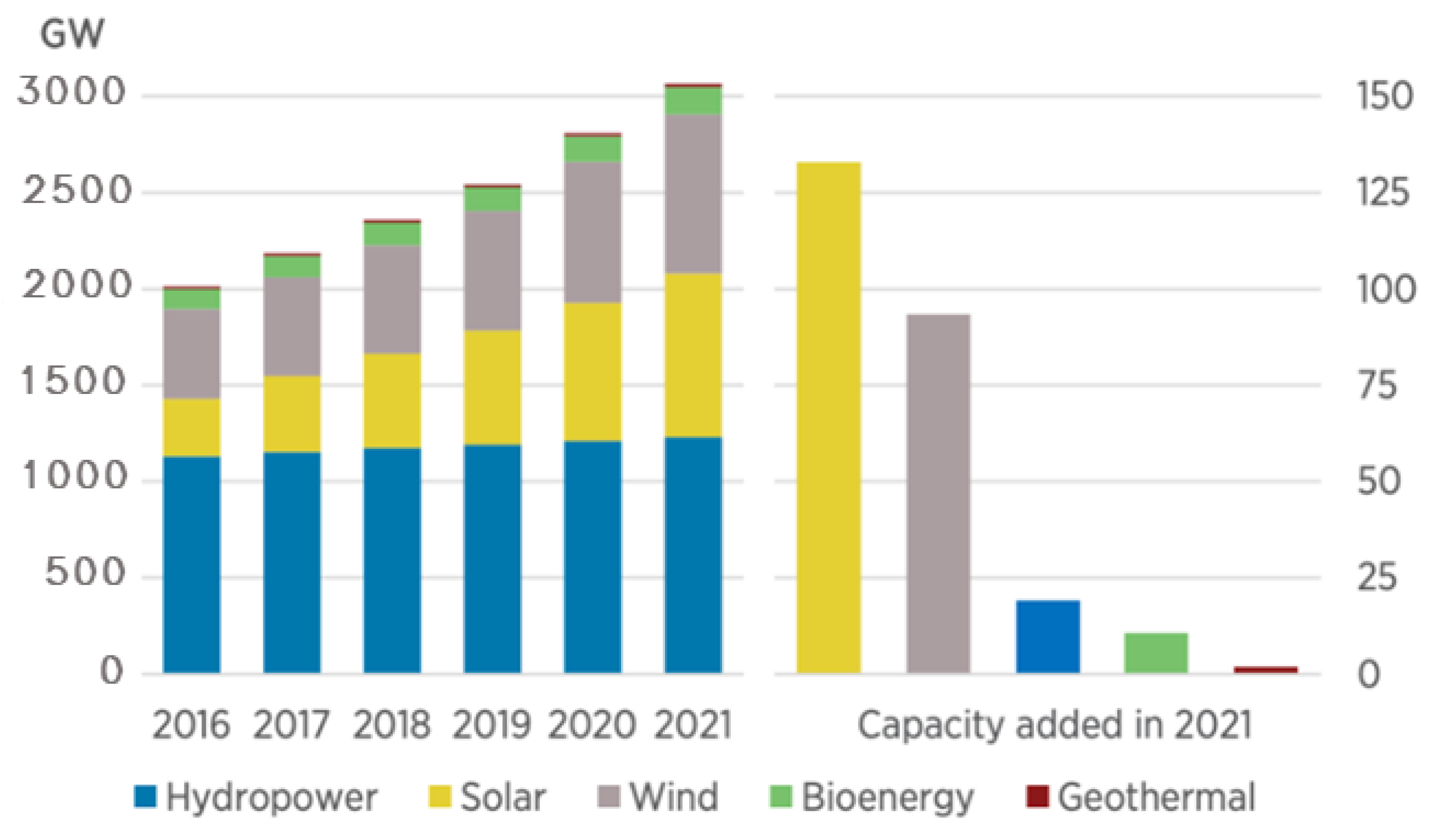
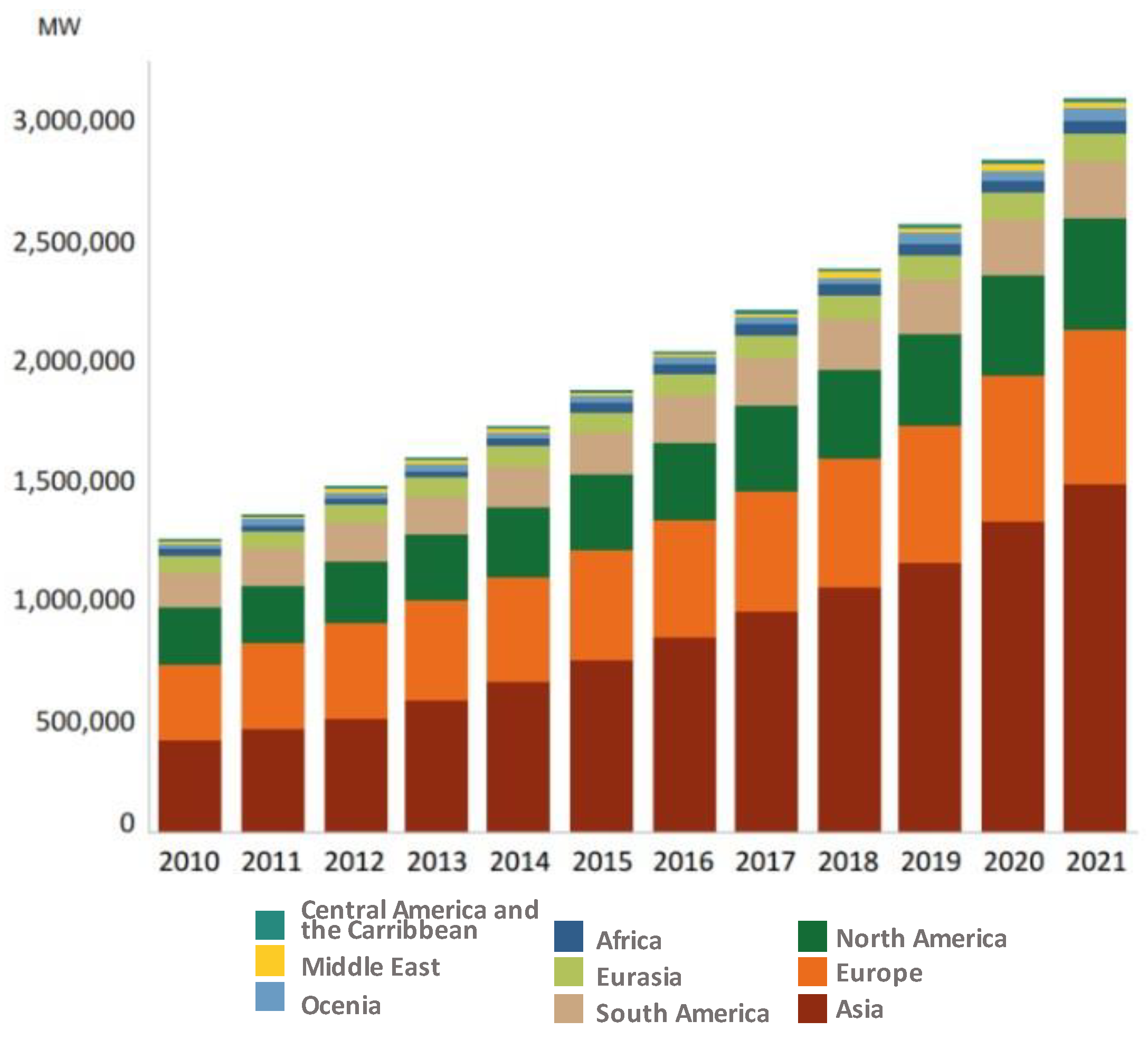

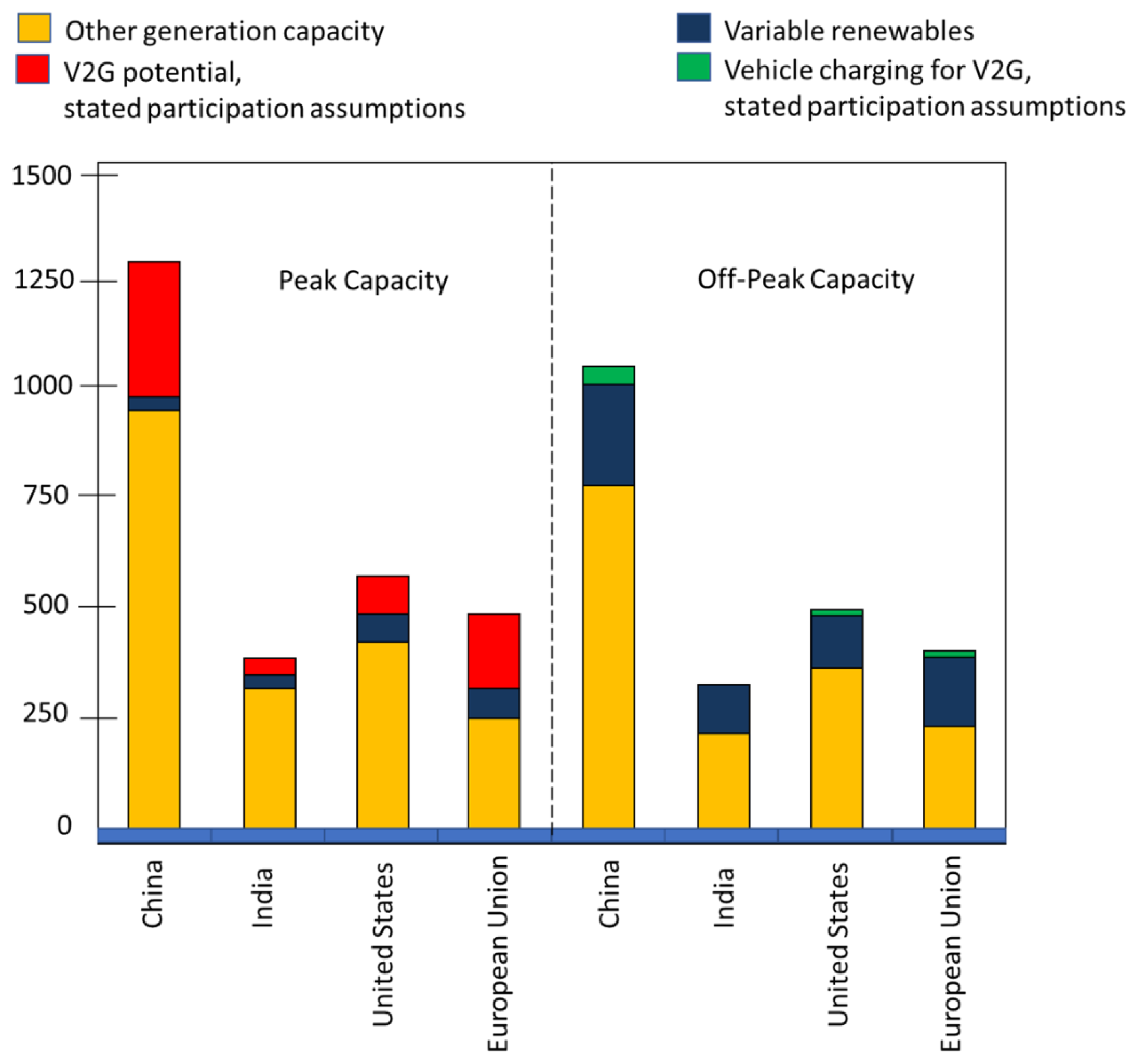
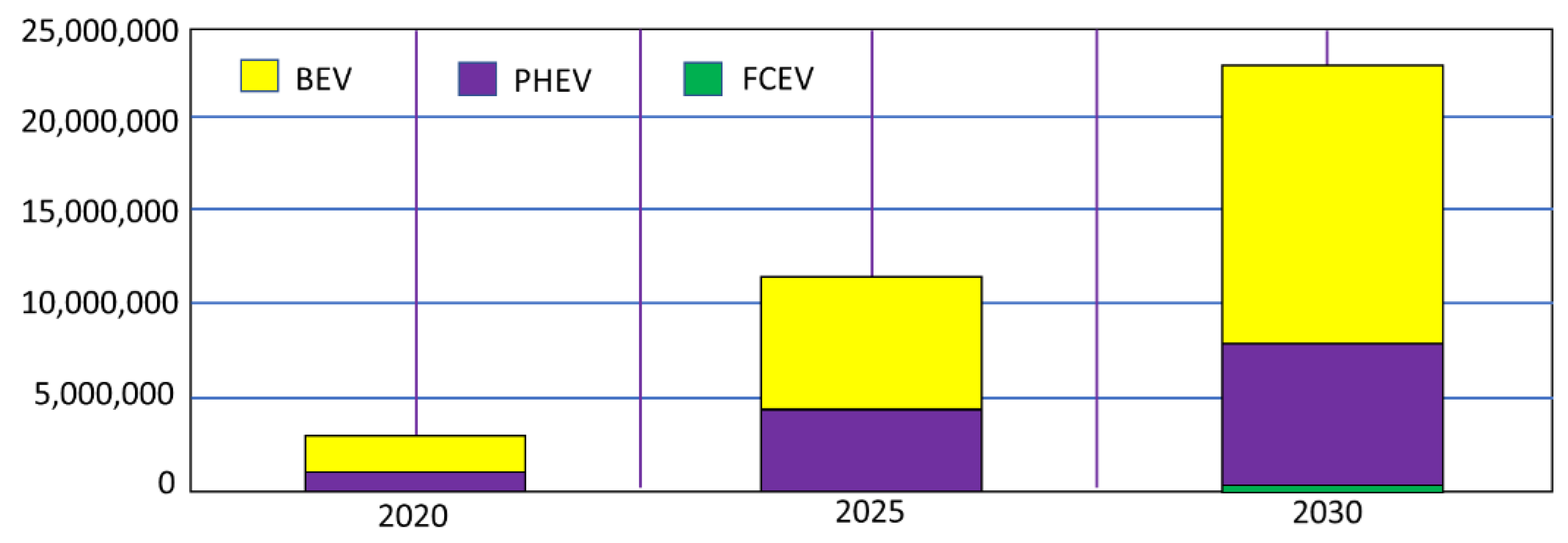
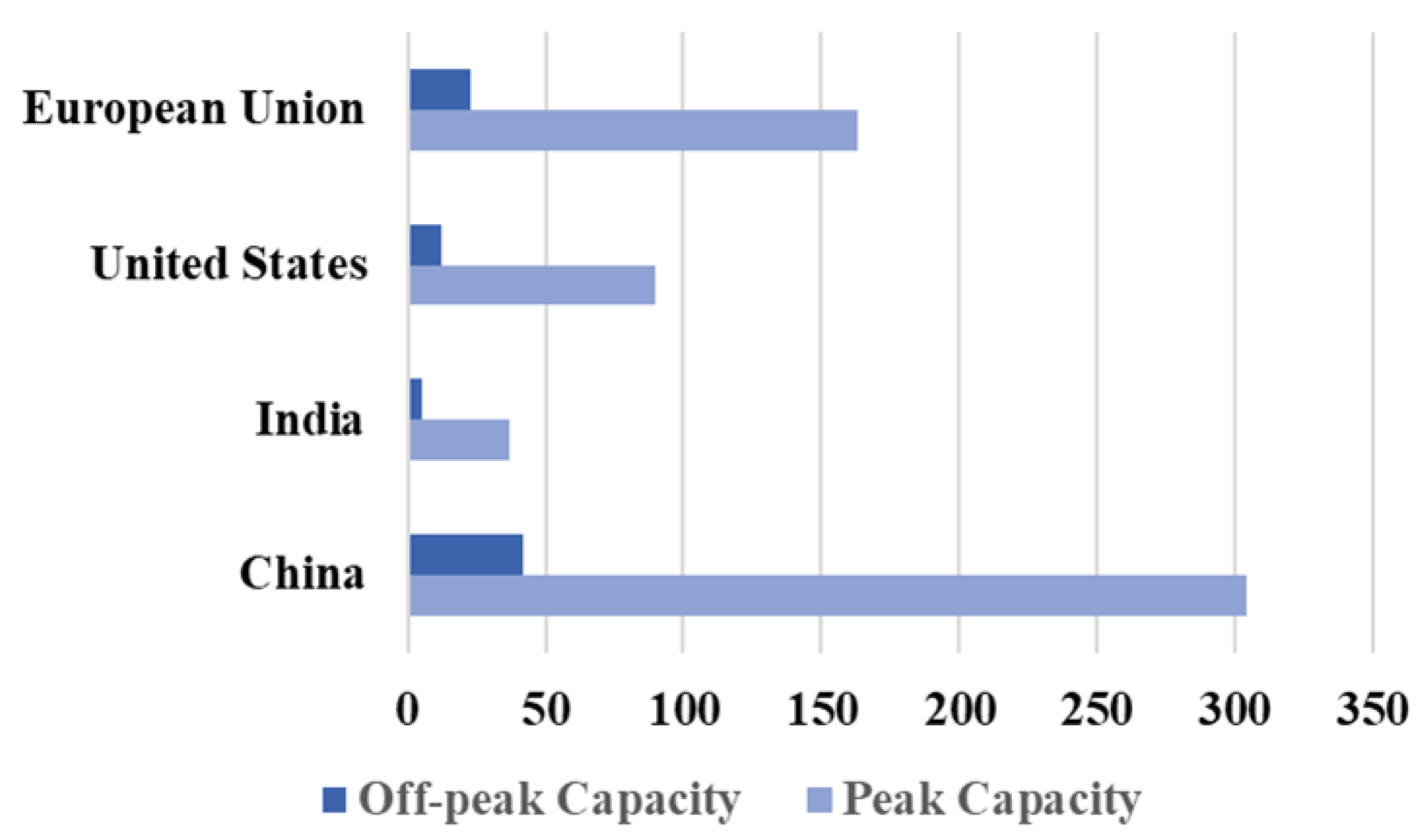


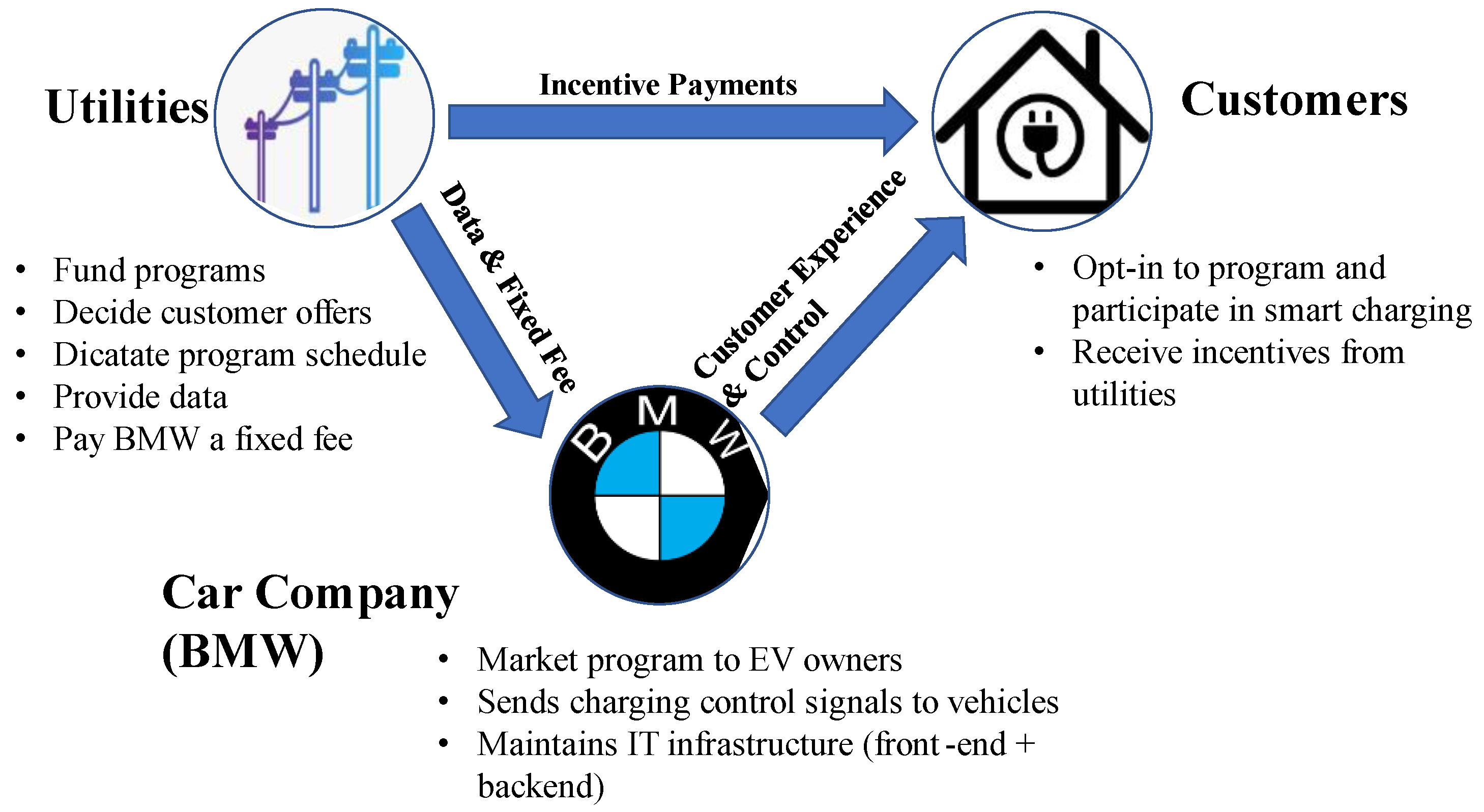
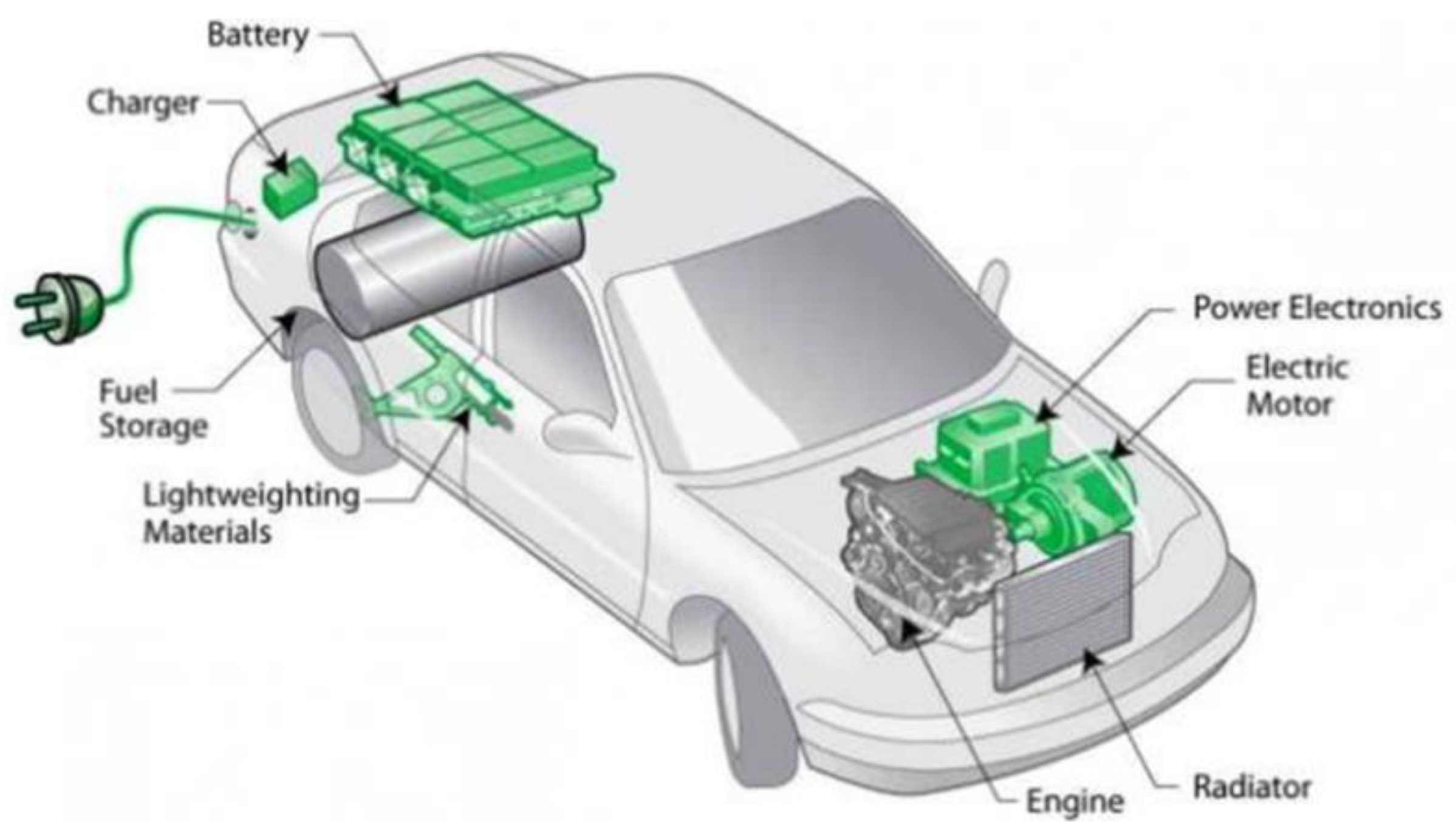
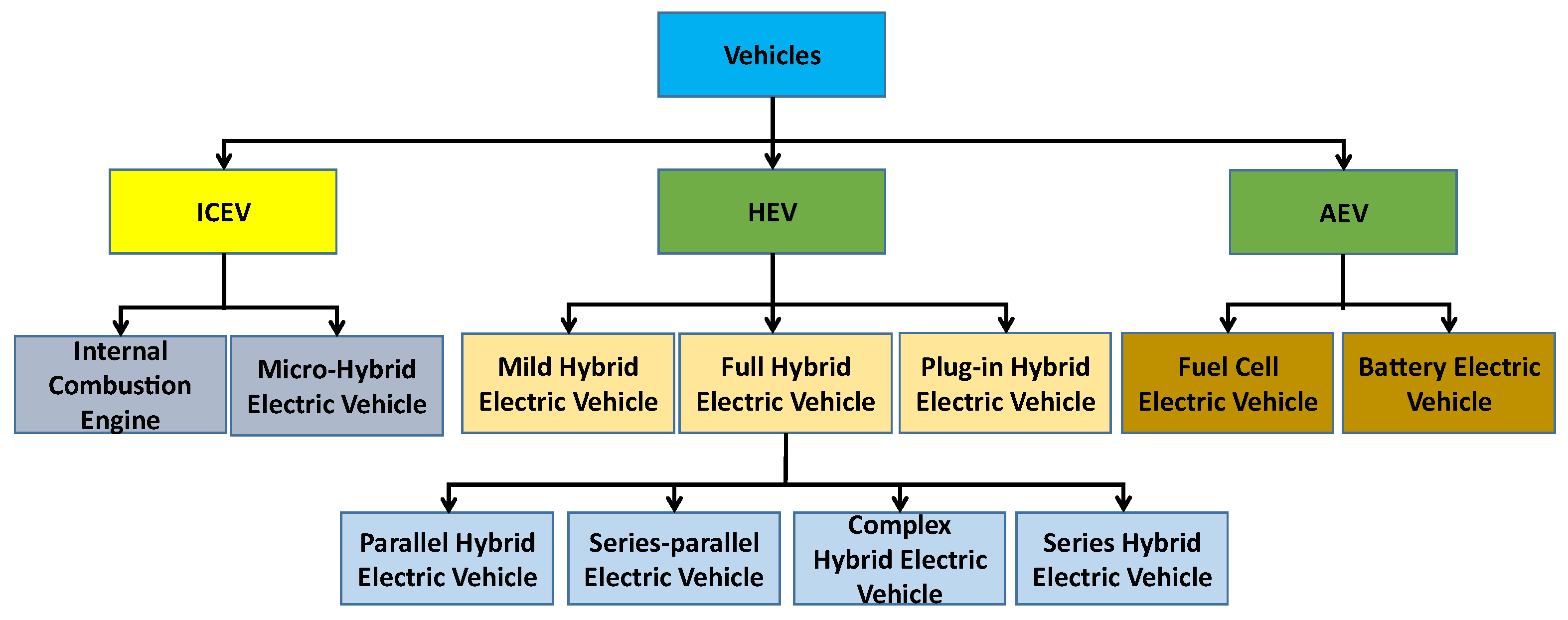

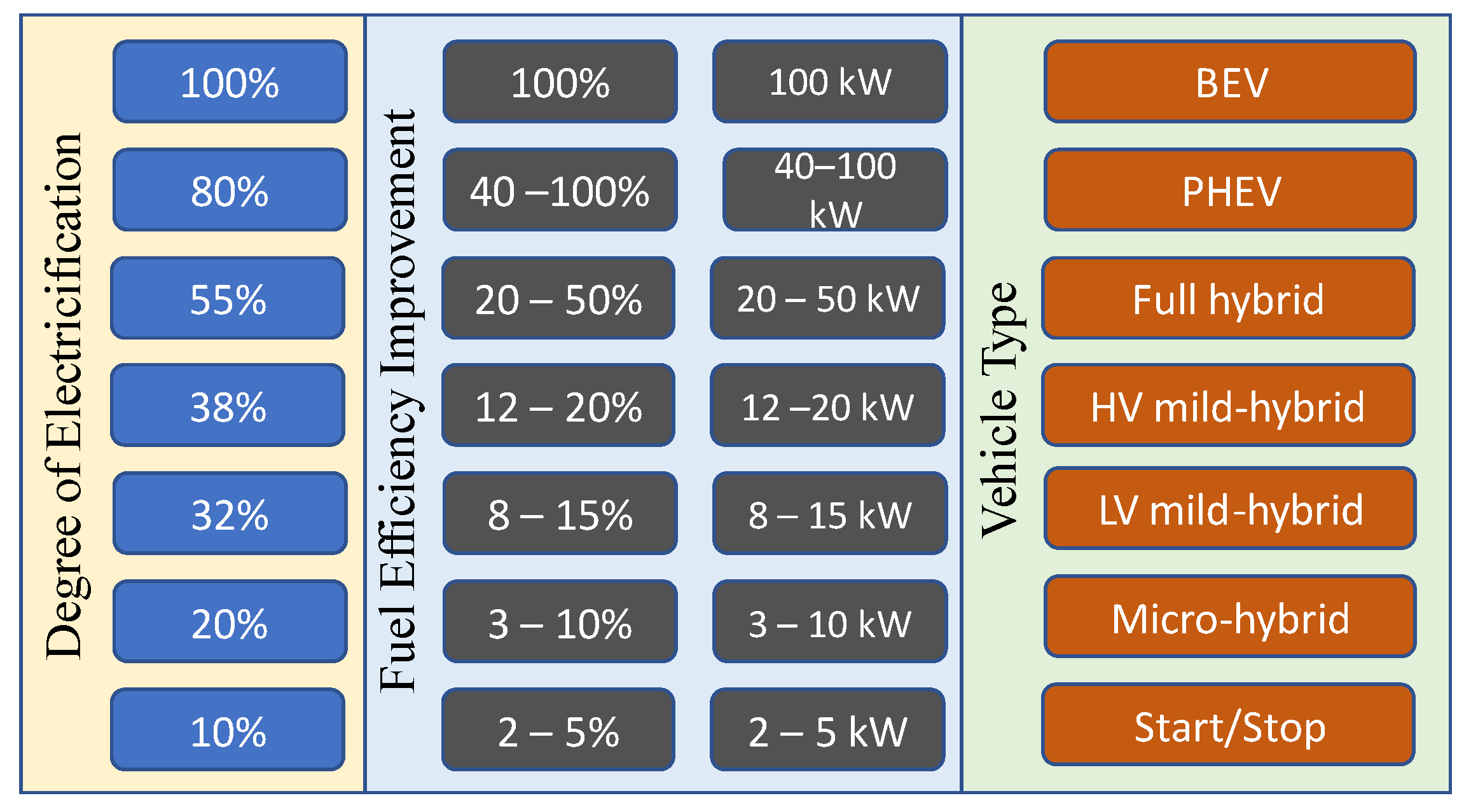
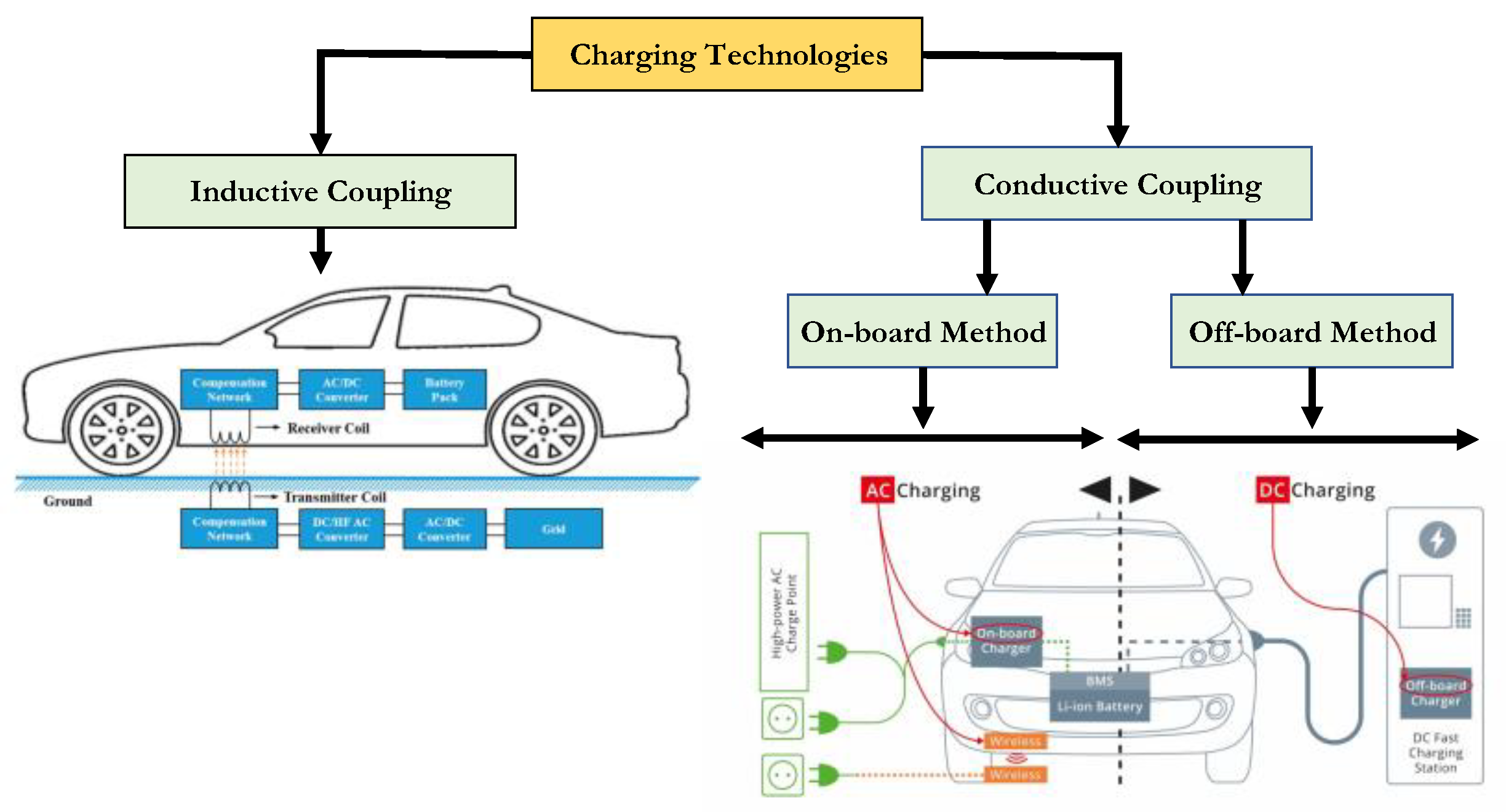
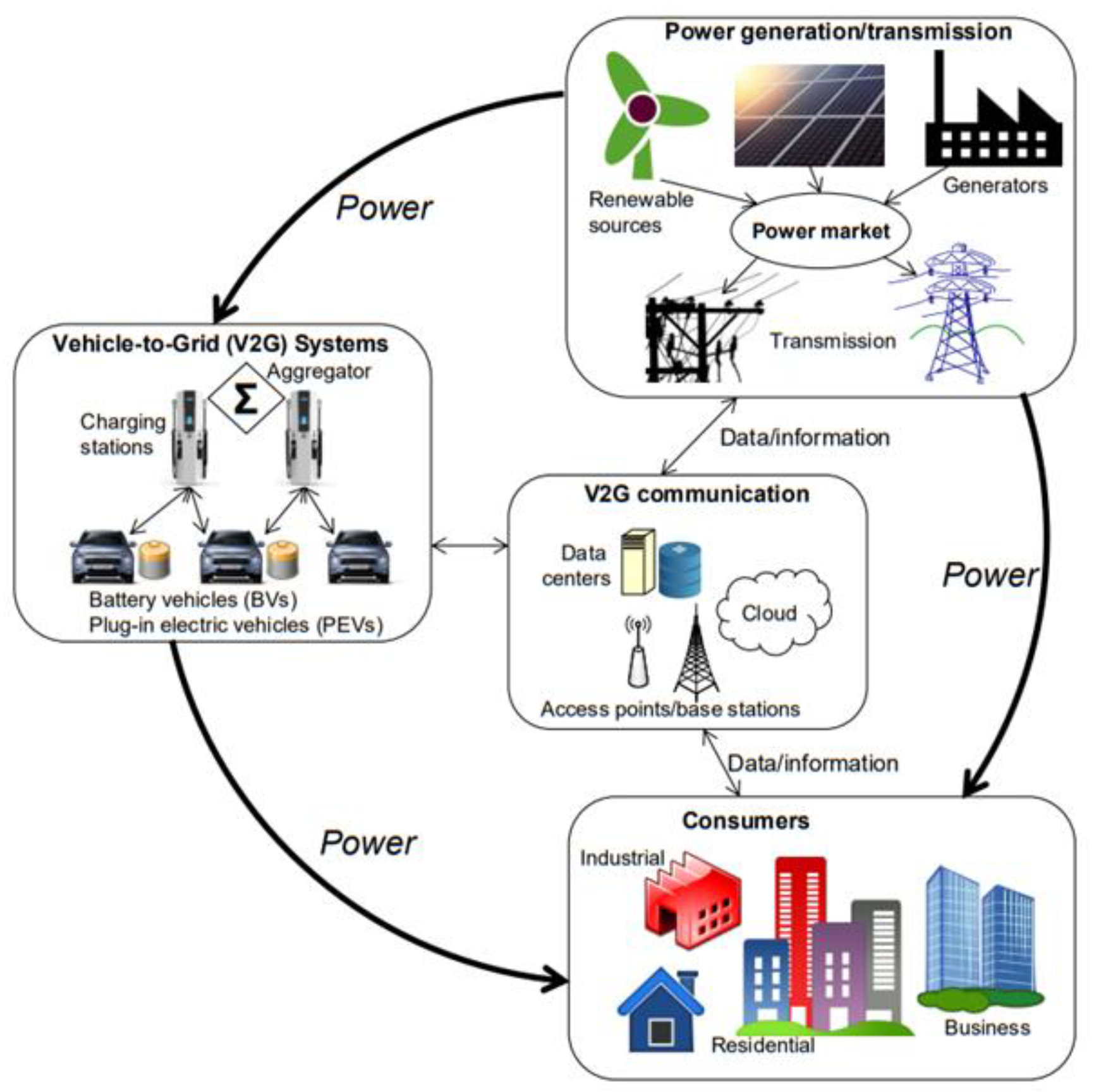
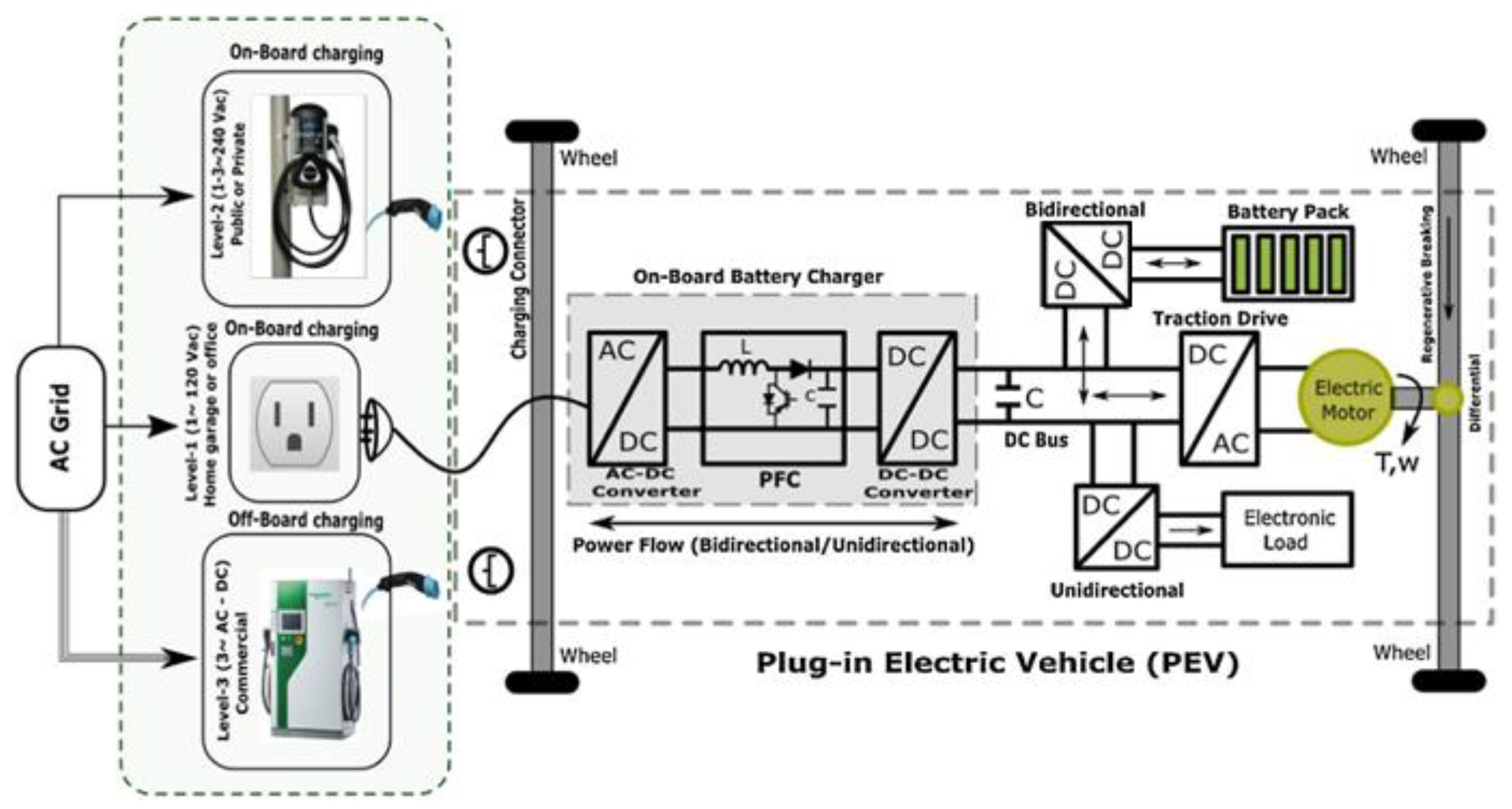
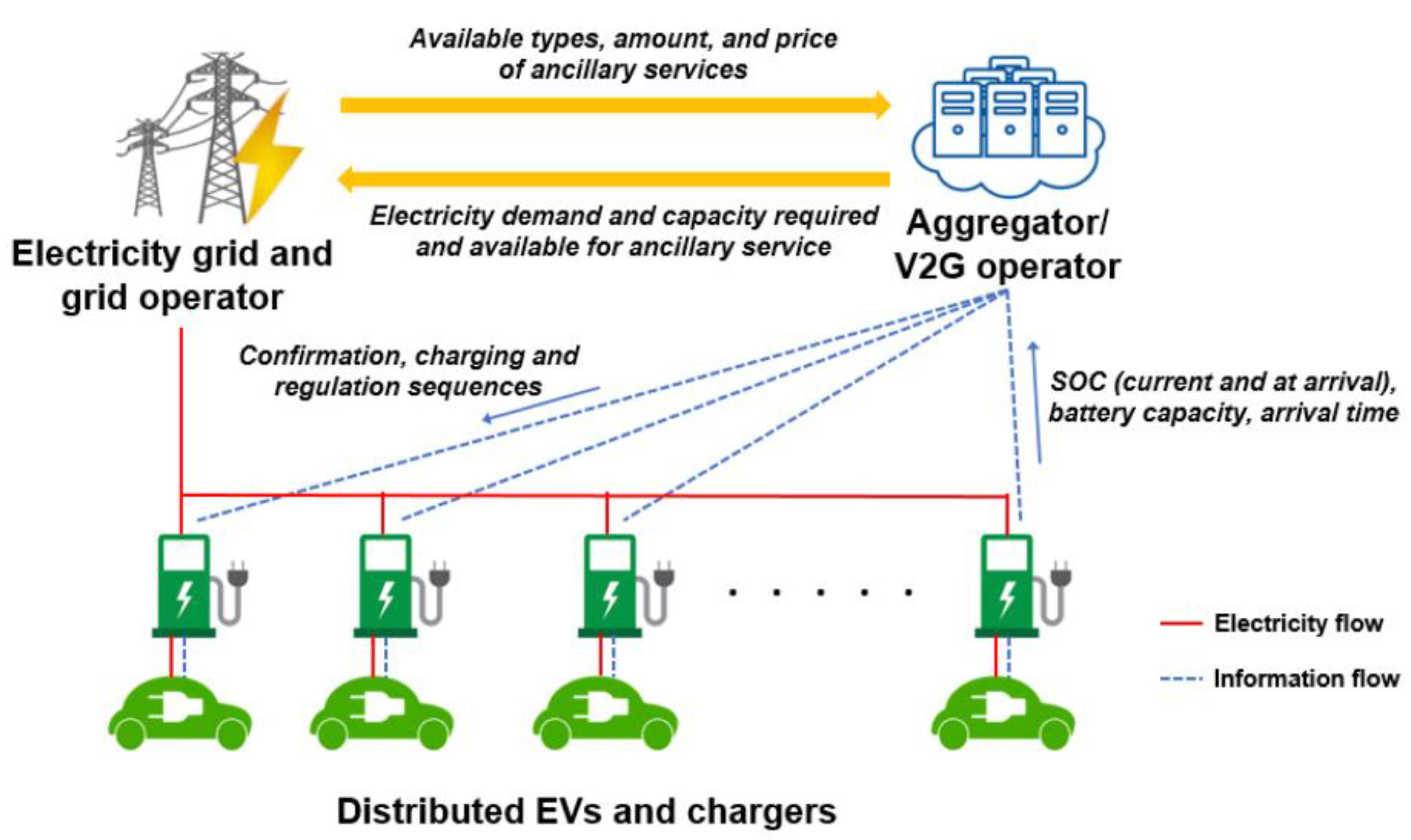
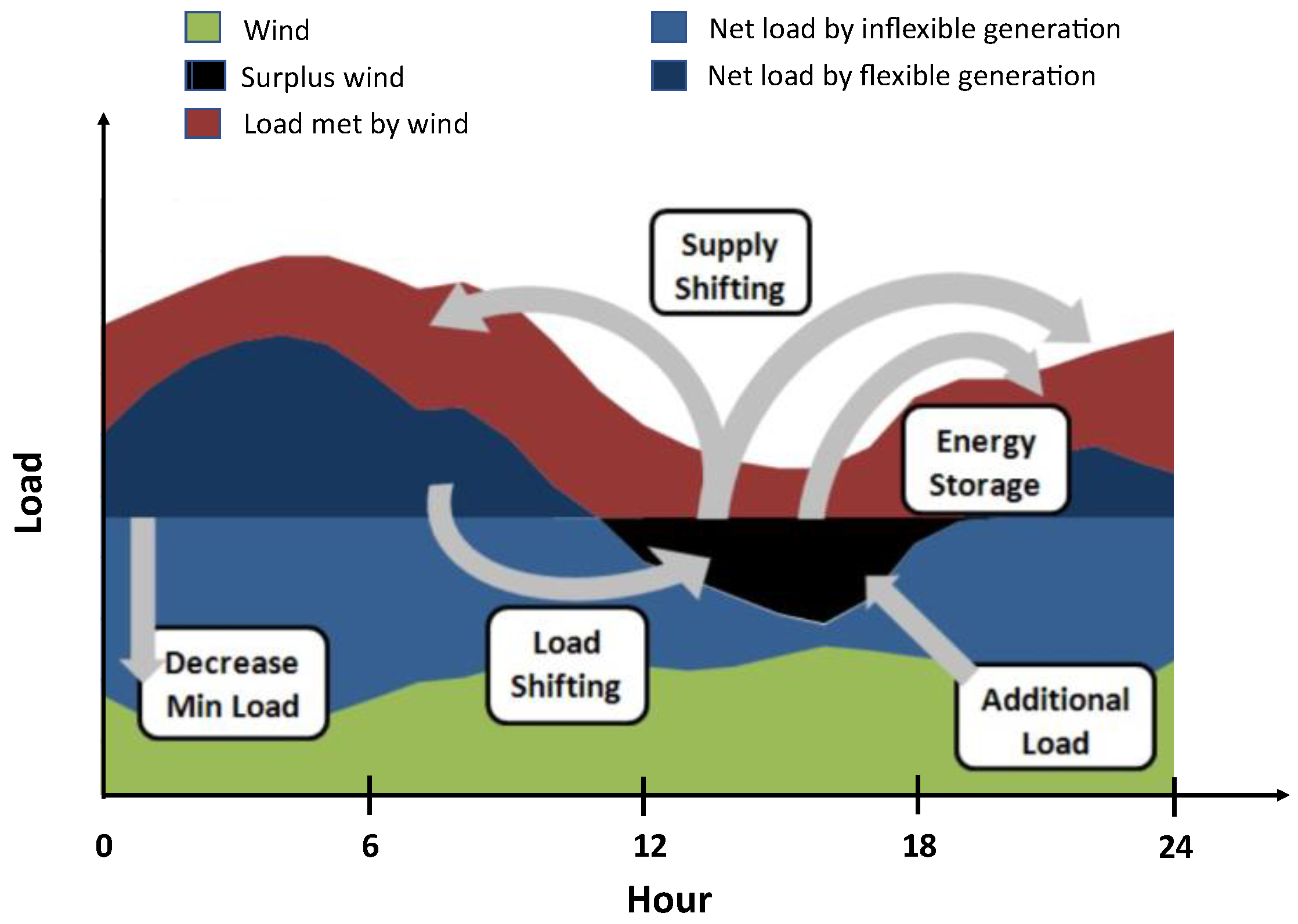
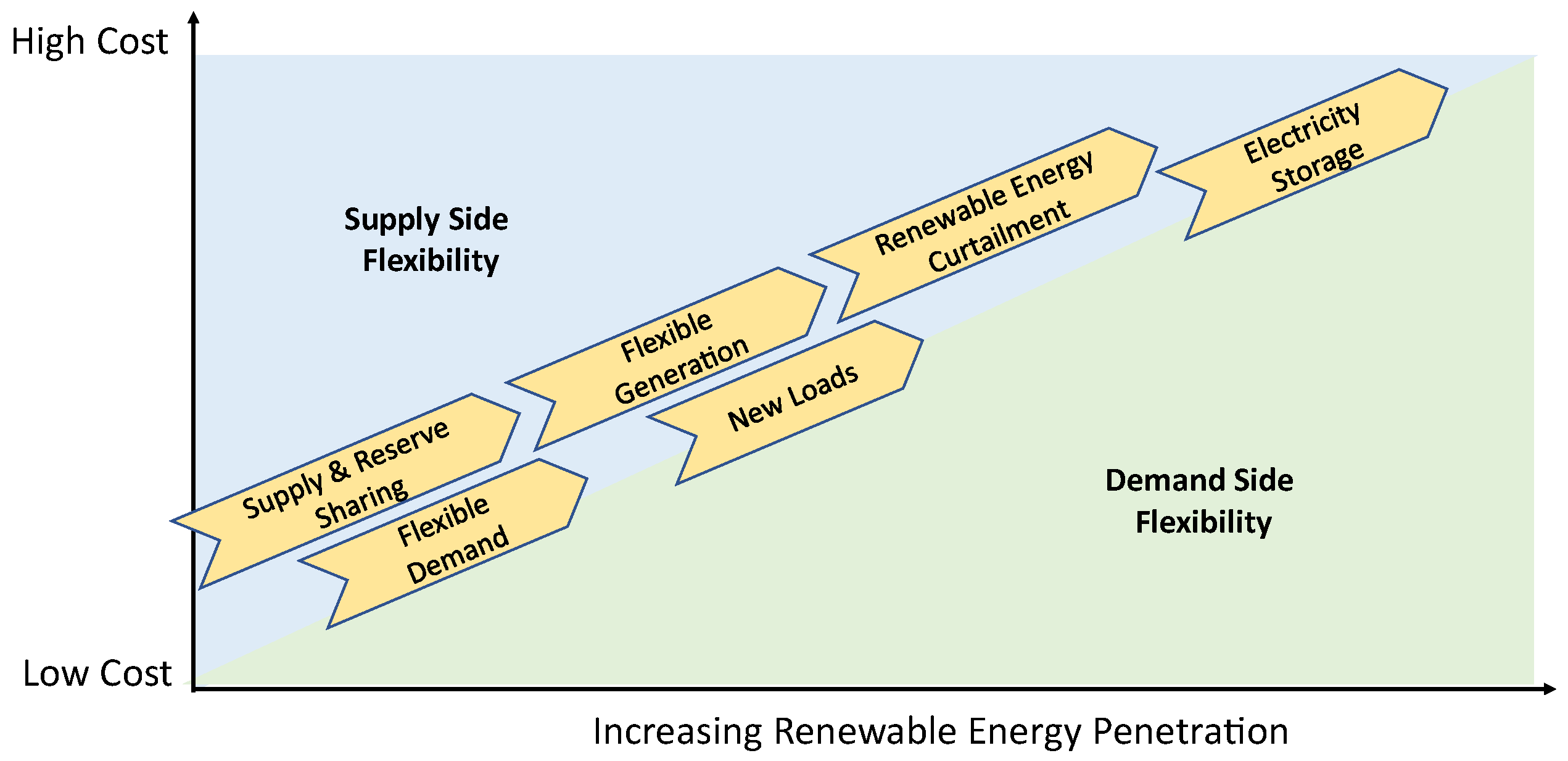
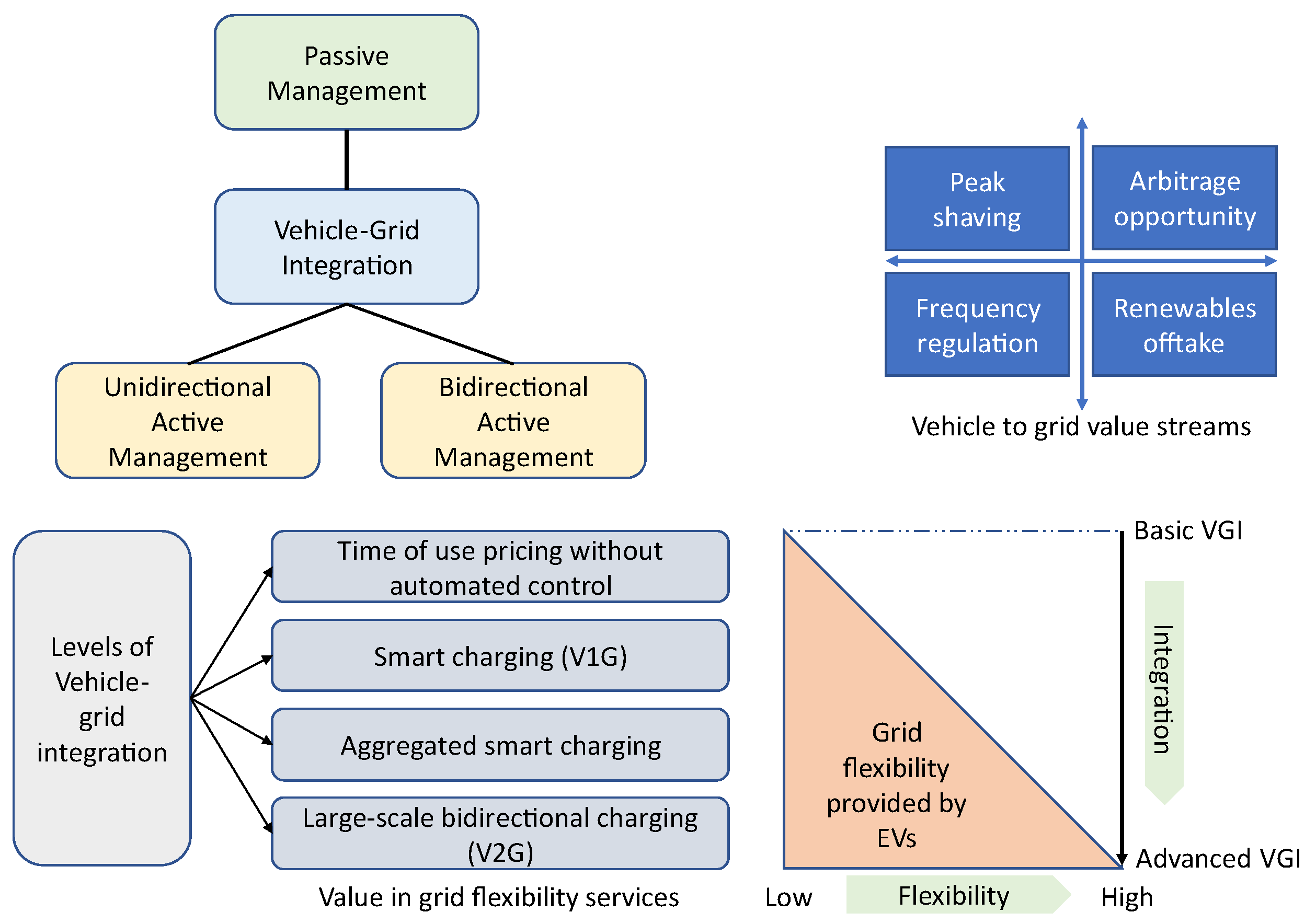

| Country | China | USA | Europe | Korea | Japan | New Zealand | Canada | |||||||
|---|---|---|---|---|---|---|---|---|---|---|---|---|---|---|
| Germany | UK | Norway | Iceland | Sweden | Netherlands | France | Switzerland | |||||||
| increase in electric car stock in 2020 | 4.5 million | 1.7 million | 3.2 million | 0.7 million | ||||||||||
| electric car stock share of BEVs | 80% (0.96 million) | 78% (230,100) | - | 62% (109,120) | 73% (56,210) | - | - | 82% (59,040) | 60% (111,000) | - | 0.4 million | |||
| increase in electric car stock share in 2021 | 46% | - | 32% | - | - | - | - | |||||||
| new electric cars registered | 1.2 million | 295,000 | 395,000 | 176,000 | 77,000 | - | 28,000 | 72,000 | 185,000 | - | 31,000 | 29,000 | - | 51,000 |
| electric car market share in 2021 | 30.00% | 15.00% | - | 8% | <1% | - | 3% | 30.00% | 15.00% | - | 8% | <1% | - | 3% |
| electric car vehicle sales share | 6% | ~2% | ~14% | ~12% | 75% | 50% | 32% | 25% | ~12% | - | 2.90% | 0.60% | −22% | 0% |
| EV Technology | Key Features | Key Vulnerabilities | Power Ratings | Charger Ratings | Refs. | ||
|---|---|---|---|---|---|---|---|
| DC | AC | Slow Charger | Fast Charger | ||||
| Battery Electric Vehicle (BEV) |
|
| 4 kW to 22 kW | 40 kW to 221 kW | 3 h to 13 h | 18 min to 90 min | [61] |
| Hybrid Electric Vehicle (HEV) |
|
| 21 kW to 185 kW | - | 2 h to 22 h | up to 20 min | [62] |
| Plug-in Hybrid Electric Vehicle (PHEV) |
|
| 1 kW to 19 kW | 50 kW to 350 kW | 1.5 h to 20+ h | - | [63] |
| Fuel Cell Electric Vehicle (FCEV) |
|
| 100 kW | - | refueled in 5 min | - | [64,65] |
| Solar Electric Vehicle (SEV) |
|
| 2 kW to 22 kW | 50 kW to 300 kW | 4 h to 7 h | 20 min | [66] |
| Category | Key Features | Auxiliary Units | Wireless Charging Range (Distance, Frequency) | Wireless Power Transfer Class | Refs. |
|---|---|---|---|---|---|
| Inductive wireless charging station (IWCS) |
| Power factor correction circuit, h-bridge, rectifier, and filter | Operating range: 19 to 50 kHz Distance: 1.5 cm or less | WPT1: 3.7 kVA | [67,68,69,70] |
| Capacitive wireless charging station (CWCS) |
| Magnetic gear, rectifier, and filter | Operating range: 100 to 600 kHz. | WPT2: 7.7 kVA | |
| Permanent magnet-gear wireless charging station (PMWCS) |
| Rectifier and filter | Operating range: up to 150 Hz (for 1 kW) | WPT3: 11 kVA | |
| Resonant wireless inductive charging station (RIWCS) |
| Series-parallel compensating units, rectifier, and filter | Operating range: 10 Hz to 150 Hz | WPT4: 22 kVA |
| Component Requirement | Rating of Smart Meter | Wireless Communication Technology Used | Rating of Wireless Communication Technology | Control Strategy Used | Power Requirement | Cost | Refs. | ||
|---|---|---|---|---|---|---|---|---|---|
| DC | AC | ||||||||
| Unidirectional V2G (vehicle-to-grid) | Utility gird, Electric Vehicle, State of charge controller, AC-DC converter, DC-DC converter, Controller, Battery storage | - | IEEE 802.11p | 5.85–5.925 GHz, 3 to 27 Mb/s (Data Rate) over a bandwidth of 10MHz, 1–1000 m | Real-time smart load management (RT-SLM); Virtual Synchronous Machine Control (VSM); Multi-Agent Control (MAC); Fuzzy Logic Controller (FLC) | 50 kW–250 kW | 1-phase: 240 V, 15 A, up to 4 kW; 3-phase: 20 A, 14.4 kW, up to 250 kW | Without EV: $7.07/kWh With EV: $ 8.17/kWh | [43,81,82,83,84,85] |
| IEEE 802.15.1 | 2.4 GHz, 1–100 m | ||||||||
| Converged fiber wireless (Fi-Wi) communications * | 5 GHz, 10 Gb/s, 1–40 m (indoor) | - | |||||||
| Bi-directional V2G (vehicle-to-grid and grid to vehicle) | Utility gird, Electric Vehicle, bi-directional charger, Controller, Battery storage, DC-DC converter, DC-AC converter, AC-DC converter, AC -AC converter | VT: 0–600V CT: 0–25 A Internal Resistance: 25 ohm | ZigBee 868 | MHz (Europe) 10–100 m 915 MHz (North America) 2.4 GHz (Worldwide) | Model predictive control algorithm; Aggregated Control Strategies | 7.4 kW–19.2 kW | 1-phase: 0 to 7 kW; 3-phase: 7 kW to 22 kW | $399 to $3600 (charger cost) | [86,87,88,89,90] |
| Near Field Communication (NFC) | 13.56 MHz, 5–10 cm | ||||||||
| Bluetooth | 2.4 GHz | ||||||||
| IEEE 802.11p | 5.85–5.925 GHz, 500–1000 m | ||||||||
| WiMAX | 2–6 GHz | ||||||||
| Converged fiber wireless (Fi-Wi) communications * | 5 GHz, 10 Gb/s, 1–40 m (indoor) | ||||||||
| V Models | Years of Production | Country of Manufacture | Range | Battery Pack Capacity | Max Charging Power (AC) | Max Charging Power (DC) | Avg. Charging Speed (DC) | Battery Chemistry | Charging Time | Charging Voltage | Battery Weight | Battery Pack |
|---|---|---|---|---|---|---|---|---|---|---|---|---|
| Chevrolet Bolt EV | 2022 | USA (Chevrolet) | 417 km | 65 kWh | 11 kW | 55 kW | ~247 km/h | Lithium-ion battery | 3 h at 115 V AC 15A | 120 V, 240 V | 50 kg | 3 Li-ion packs, one for hybrid, two for EV |
| Chevrolet Bolt EV | 2022 | The USA, South Korea (Chevrolet) | 398 km | 65 kWh | 11 kW | - | - | Lithium iron phosphate | 7 h at 240 V AC | 120 V, 240 V | 430 kg | 288 cells |
| Audi Q4 e-tron | 2021 | Germany (Audi) | 488 km | 82 kWh | 11 kW | 126 kW | ~525 km/h | Lithium-Ion | 3 h at 230V AC 16 A | 450 V | 350 kg to 500 kg | 10 or 12 modules containing the individual battery cells in an aluminum casing |
| BAIC EU5 | 2018 | China (BAIC) | 416 km | 53 kWh | 7 kW | 60 kW | ~330 km/h | Ternary lithium-ion battery | 9 h | - | 380 kg | - |
| BAIC LITE | 2018 | China (BAIC) | 300 km | 30 kWh | 7 kW | 60 kW | ~420 km/h | Ternary lithium battery | - | - | 142 kg | - |
| BJEV EC3 | 2019 | China (BAIC) | 301 km | 30.7 kWh | 7 kW | 60 kW | ~412 km/h | Ternary lithium battery | 9 h | 220 V | - | - |
| BJEV EX3 | 2019 | China (BJEV) | 501 km | 61.3 kWh | 7 kW | 60 kW | ~343 km/h | Lithium-ion Electric | 10 h | 120 V, 240 V AC | - | - |
| BJEV EC5 | 2019 | China (BJEV) | 403 km | 48 kWh | 7 kW | 60 kW | ~353 km/h | Ternary lithium battery | 8 h 42 min at 230 V AC 16 A | 230 V | 353 kg | - |
| BMW i4 | 2021 | Germany (BMW) | 590 km | 83 kWh | 11 kW | 200 kW | ~995 km/h | Pressure lithium-ion | 8 h 45 min at 380 V AC 16 A | 398.5 V | 550 kg | High-pressure lithium-ion 83.9 kWh, four modules with 72 cells each and three 12-cell modules |
| BMW iX | 2021 | Germany (BMW) | 630 km | 111 kWh | 11 kW | 200 kW | ~795 km/h | Lithium-ion battery | 10.5 h on 240V AC 48 A | - | - | - |
| BOLLINGER B2 | 2021 | USA (BOLLINGER MOTORS) | 322 km | 120 kWh | - | - | - | Lithium-ion | 10 h at 220 V | 350 V, 700 V | - | The Bollinger Motors battery pack is composed of modules in 35 kWh strings that can be connected in series or parallel to form a variety of pack sizes and configurations. |
| BOLLINGER B1 | 2021 | USA (BOLLINGER MOTORS) | 322 km | 120 kWh | - | - | - | Lithium-ion | 10 h at 110 V, 220 V | 110 V, 220 V | - | 8 110 V outlets and 1 220 V outlet |
| Brilliance Auto H230 | 2017 | China (Brilliance Auto) | 158 km | 24 kWh | 7 kW | 60 kW | ~277 km/h | Lithium-ion battery | 14 h 49 min at 230 V, 10 A | - | 250 kg | - |
| BYD Song Pro EV | 2019 | China (BYD) | 405 km | 71 kWh | 7 kW | 60 kW | ~240 km/h | Lithium iron phosphate | 12 h 52 min at 230 V, 16 A | - | - | lithium-ion battery cells are made of LFP cathodes |
| BYD E5 | 2018 | China (BYD) | 405 km | 51.2 kWh | 7 kW | 60 kW | ~332 km/h | Lithium iron phosphate | 8 h 08min | 604.8 V | 365 kg | 168 single cells are divided into 13 battery modules connected in series; each module has a single battery inside, and the nominal voltage of every single battery is 3.2 V |
| BYD S2 | 2019 | China (BYD) | 305 km | 40.62 kWh | 7 kW | 60 kW | ~315 km/h | Ni-Co lithium manganate battery | 6 h 27 min | - | - | - |
| BYD Qing Super Version Pro EV | 2020 | China (BYD) | 520 km | 69.5 kWh | 7 kW | 60 kW | ~314 km/h | Ternary lithium battery | 132.75 min | - | - | - |
| BYD Full New Yuan | 2019 | China (BYD) | 305 km | 40.62 kWh | 7 kW | 60 kW | ~315 km/h | Ternary lithium battery | 6 h | 800 V | - | LFP chemistry and cell-to-pack system |
| BYTON M-Byte | 2019 | China (BYTON) | 402 km | 71 kWh | 150 kW | ~595 km/h | lithium-ion battery | 4.5 h | 110 V, 120 V | - | - | |
| Changan EV460 | 2018 | China (Changan) | 430 km | 52.56 kWh | 7 kW | 60 kW | ~344 km/h | lithium iron phosphate | 8 h | - | 372 kg | - |
| -Changan CS15EV400 | 2019 | China (Changan) | 351 km | 42.92 kWh | 7 kW | 60 kW | ~343 km/h | ternary lithium battery | 6 h 49 min | - | - | |
| Chery Tiggo3xe | 2018 | China (Chery) | 401 km | 53.6 kWh | 7 kW | 60 kW | ~314 km/h | ternary lithium battery | 8 h | - | 395 kg | built from the most advanced NMC cells |
| Chery eQ1 | 2020 | China (Chery) | 301 km | 30 kWh | 4 kW | 50 kW | ~351 km/h | ternary lithium battery | 7 h | - | 226 kg | pouch-type cells with an energy density of 140.2 Wh/kg |
| Dongfeng S50 EV | 2018 | China (Dongfeng) | 410 km | 57 kWh | 7 kW | 60 kW | ~302 km/h | lithium-ion battery | 11 h | - | 359 kg | - |
| Fiat 500 | 2020 | Italy (Fiat) | 320 km | 42 kWh | 11 kW | 85 kW | ~453 km/h | lithium-ion battery | 14 h | 12.6 V | 100 kg | - |
| Ford Mustang Mach-E | 2020 | Mexico, USA (Ford) | 610 km | 98 kWh | 11 kW | 150 kW | ~654 km/h | lithium-ion battery | 10.1 h | 120 V, 240 V | 485 kg | 288 lithium-ion cells in the standard-range version and 376 lithium-ion cells in the extended-range |
| Tesla Model Y | 2020 | USA (Tesla) | 480 km | 75 kWh | 11 kW | 250 kW | ~1120 km/h | lithium iron phosphate | 8 h 15 min | 400 V | 363 kg | 2170 cells with NCA chemistry |
| Tesla Roadster | 2022 | USA (Tesla) | 998 km | 200 kWh | 22 kW | 250 kW | ~873 km/h | lithium-ion battery | 10 h 45 min | 375 V | 833 kg | 6831 lithium-ion batteries, cells size: 18 mm in diameter by 65 mm long |
| Tesla Cybertruck | 2022 | USA (Tesla) | 805 km | 200 kWh | 11 kW | 250 kW | ~704 km/h | lithium-ion battery | 21 h 30 min | 120 V, 240 V | 1406 kg | - |
| Tesla Model 3 | 2019 | USA, China (Tesla) | 560 km | 82 kWh | 11 kW | 250 kW | ~1195 km/h | lithium-ion battery | 12 h 15 min | 120 V, 240 V, 480 V | 480 kg | four longitudinal modules, each containing the groups (bricks), the Standard Range version carries 2976 cells arranged in 96 groups of 31 |
| Tesla Model Y | 2020 | USA, China (Tesla) | 505 km | 74 kWh | 11 kW | 250 kW | ~1194 km/h | lithium-ion battery | - | - | - | 4416 cells |
| Tesla Model X | 2019 | USA, Holland (Tesla) | 580 km | 100 kWh | 16 kW | 250 kW | ~1015 km/h | lithium-ion battery | 6 h 30 min to 10 h | 240 V | 625 kg | around 444 Panasonic NCR18650B cells running in 74p6s configuration |
| Geely EV500 | 2019 | China (Geely) | 500 km | 62 kWh | 7 kW | 60 kW | ~339 km/h | lithium-ion battery | 9 h | 220 V | - | Ternary Lithium Battery + 3.0 ITCS Intelligent Temperature Control Management System |
| Geely Gse | 2019 | China (Geely) | 450 km | 61.9 kWh | 7 kW | 60 kW | ~305 km/h | lithium-ion battery | 9 h | 220 V | - | - |
| Haima E3 | 2018 | China (Haima) | 315 km | 46.6 kWh | 7 kW | 60 kW | ~284 km/h | lithium-ion battery | 9 h | - | 331 kg | - |
| Haima EV | 2018 | China (Haima) | 202 km | 21 kWh | 7 kW | 60 kW | ~404 km/h | lithium-ion battery | - | - | 293 kg | - |
| Hanteng Auto | 2018 | China (Hanteng) | 252 km | 42.7 kWh | 7 kW | 60 kW | ~248 km/h | lithium-ion battery | 6 h 47 min | - | - | - |
| Honda e | 2019 | Japan (Honda) | 222 km | 35.5 kWh | 6.6 kW | 56 kW | ~245 km/h | lithium-ion battery | 5 h 45 min | 230 V | - | - |
| Honda Clarity Electric | 2017 | USA (Honda) | 143 km | 25.5 kWh | 6.6 kW | 80 kW | ~314 km/h | lithium-ion battery | 3 h 30 min | 120 V, 240 V | 100 kg | - |
| GMC Hummer EV | 2022 | USA (Hummer) | 560 km | 200 kWh | - | - | - | Altium-powered and lithium-ion battery | 3 h 20 min | 120 V | 1325 kg | 24 individual battery modules with wireless management and parallel cooling systems |
| Hyundai Ioniq 5 | 2022 | South Korea (Hyundai) | 485 km | 72 kWh | 11 kW | 221 kW | ~1042 km/h | lithium-ion battery | 6 h 43 min | 800 V | 450 kg | 12 pouch cells and stores about 2.4 kWh of energy |
| Hyundai Kona Electric | 2021 | South Korea (Hyundai) | 449 km | 64 kWh | 11 kW | 77 kW | ~378 km/h | lithium-ion polymer battery | 9 h 35 min | 356 V | 453.6 kg | paired with an electric motor that delivers 204 PS (150 kW) |
| Hyundai Ioniq Electric | 2019 | South Korea (Hyundai) | 311 km | 40 kWh | 7 kW | 44 kW | ~239 km/h | lithium-ion polymer battery | 13 h | 360 V | 271.8 kg | 96 battery cells arranged in 12 modules |
| JAC iEVS4 | 2019 | China (JAC) | 355 km | 55 kWh | 7 kW | 60 kW | ~271 km/h | lithium-ion battery | - | - | - | - |
| Jaguar I-PACE | 2017 | Austria (Jaguar) | 480 km | 90 kWh | 7 kW | 100 kW | ~373 km/h | lithium-ion battery | 10.1 h | 240 V | 610 kg | 432 pouch cells in 36 modules that use nickel-manganese-cobalt battery chemistry. |
| Kia EV6 | 2022 | South Korea (Kia) | 490 km | 77 kWh | 11 kW | 233 kW | ~1038 km/h | lithium-ion phosphate (LFP) battery | 7 h 10 min | 697 V | 477 kg | Nickel-Cobalt-Manganese (80/10/10) |
| Kia Niro EV | 2019 | South Korea (Kia) | 455 km | 64 kWh | 7.2 kW | 77 kW | ~383 km/h | Lithium Ion Polymer Battery (LIPO) | 10 h 30 min | 356 V | 457.22 kg | - |
| Lifan 820EV | 2018 | China (Lifan) | 330 km | 60 kWh | 7 kW | 60 kW | ~231 km/h | ternary lithium battery | 10 h 52 min | 320 V | 420 kg | - |
| Lucid Air | 2022 | USA (Lucid) | 660 km | 112 kWh | 19 kW | 300 kW | ~1238 km/h | lithium-ion battery | 13 h | 240 V | - | thousands of 21700-format cylindrical cells |
| Mazda MX-30 EV | 2020 | Japan (Mazda) | 210 km | 35.5 kWh | 6.6 kW | 50 kW | ~207 km/h | lithium-ion battery | 5 h 30 min | 355 V | - | - |
| Mercedes EQS | 2022 | Germany (Mercedes) | 770 km | 120 kWh | 11 kW | 207 kW | ~930 km/h | lithium-ion battery | 11.25 h | 400 V | - | NCM 811 lithium-ion; Nickel, Cobalt, and Manganese in the ratio of 8:1:1, 8 to 10 cells depending on the configuration and features a liquid thermal management system |
| Mercedes EQC | 2019 | Germany, China (Mercedes) | 417 km | 80 kWh | 11 kW | 112 kW | ~409 km/h | lithium-ion battery | 11 h | - | 650 kg | 384 cells—two modules with 48 cells and four modules with 72 cells |
| Mercedes EQB | 2022 | Germany, China (Mercedes) | 419 km | 69 kWh | 11 kW | 113 kW | ~480 km/h | lithium-ion battery | 7 h 15 min | 400 V | - | - |
| Mercedes EQA | 2021 | Germany (Mercedes) | 426 km | 69 kWh | 11 kW | 112 kW | ~484 km/h | lithium-ion battery | 7 h | 400 V | - | 200 cells arranged in five modules |
| MG ZS EV | 2020 | India (MG Motors) | 262 km | 44.5 kWh | 6.6 kW | 80 kW | ~330 km/h | Nickel Manganese Cobalt (NMC) battery | 7 h 45 min | 230 V | 250 kg | 44.5 kWh liquid-cooled battery pack (CATL cells) |
| MINI Cooper SE | 2020 | UK (Mini) | 235 km | 32 kWh | 11 kW | 49 kW | ~252 km/h | lithium-ion battery | 3.5 h | 120 V | 145 kg | 12-packs of lithium-ion cells arranged in a T-shape |
| NIO ES6 | 2019 | China (NIO) | 510 km | 84 kWh | 7 kW | 60 kW | ~255 km/h | lithium-ion battery | 10 h | 220 V | 635 kg | - |
| Nissan Leaf | 2019 | Japan, USA, UK (Nissan) | 385 km | 62 kWh | 6 kW | 100 kW | ~435 km/h | lithium-ion battery | 11.5 h | 360 V | 303 kg | 192 cells; 2 in parallel and 96 in series, arranged in 24 modules |
| Nissan Ariya | 2021 | Japan (Nissan) | 500 km | 87 kWh | 22 kW | 130 kW | ~523 km/h | lithium-ion battery | 4 h 45 min | 400 V | - | - |
| Nissan e-NV200 | 2018 | Japan (Nissan) | 200 km | 40 kWh | 6.6 kW | 50 kW | ~175 km/h | lithium-ion battery | 8 h | 360 V | 267.5 kg | 48-module compact lithium-ion battery, each module contains four cells |
| Opel Corsa-e | 2019 | France (Opel) | 330 km | 50 kWh | 11 kW | 100 kW | ~462 km/h | lithium-ion battery | 7 h 15 min | 230 V | - | - |
| Polestar 2 | 2020 | China (Polestar) | 500 km | 78 kWh | 11 kW | 150 kW | ~673 km/h | lithium-ion battery | 8 h 15 min | 400 V | - | 324 pouch cells, 27 modules, liquid-cooled |
| Porsche Taycan | 2021 | Germany (Porsche) | 456 km | 93.4 kWh | 11 kW | 262 kW | ~895 km/h | lithium-ion battery | 9 h | 800 V | 630 kg | 33 cell modules consisting of 12 individual cells each (396 in total) |
| RedStar Auto | 2018 | China (RedStar) | 252 km | 32.7 kWh | 7 kW | 60 kW | ~324 km/h | lithium-ion battery | 5 h 11 min | - | 220 kg | - |
| Renault Kangoo Z.E. | 2017 | France (Renault) | 270 km | 33 kWh | 7.4 kW | - | - | lithium-ion battery | 8 h 45 min | 400 V | 255 kg | 192 cells in 12 module |
| Renault ZOE | 2020 | France (Renault) | 390 km | 52 kWh | 22 kW | 50 kW | ~263 km/h | lithium-ion battery | 1 h | 230 V | 326 kg | 192 cells; 96 in series, 2 parallel |
| Renault Twizy | 2012 | Spain (Renault) | 100 km | 6 kWh | 3 kW | - | - | lithium-ion battery | 3 h 30 min | 220 V–240 V | 100 kg | - |
| Rimac Nevera | 2021 | Croatia (Rimac) | 550 km | 120 kWh | 22 kW | 500 kW | ~1604 km/h | Lithium Nickel Manganese Cobalt Oxide (LiNiMnCoO2) | 17 h 22 min | 800 V | - | Cell format: cylindrical 2170 number of cells: 6960 |
| Rivian R1S | 2021 | USA (Rivian) | 660 km | 180 kWh | 11 kW | 160 kW | ~411 km/h | lithium-ion battery | 26 h 2 min | 400 V | - | 9 modules, 2170-type cylindrical cells (7776) |
| Rivian R1T | 2021 | USA (Rivian) | 644 km | 180 kWh | 11 kW | 160 kW | ~401 km/h | lithium iron phosphate | 12 h | 400 V | - | 9 modules, 2170-type cylindrical cells (7776) |
| SAIC MAXUS | 2019 | China (SAIC) | 350 km | 52.5 kWh | 7 kW | 60 kW | ~280 km/h | lithium-ion battery | 8 h 20 min | - | - | - |
| Škoda Citigo iV | 2019 | Slovakia (Skoda) | 265 km | 36.8 kWh | 7.2 kW | 40 kW | ~202 km/h | lithium-ion battery | 4 h 08 min | - | 248 kg | 168 cells |
| Škoda Vision IV | 2020 | Slovakia (Skoda) | 500 km | 83 kWh | 11 kW | 125 kW | ~527 km/h | lithium-ion battery | 6 h to 8 h | 230 V | 248 kg | - |
| Smart EQ | 2019 | France (Smart) | 153 km | 17.6 kWh | 22 kW | - | - | lithium-ion battery | 3 h | 400 V | - | - |
| Sono Sion | 2020 | Germany (Sono) | 255 km | 35 kWh | 22 kW | 50 kW | ~255 km/h | lithium-ion battery | 2.5 h | 230 V | 250 kg | - |
| Volvo XC40 Recharge | 2020 | China (Volvo) | 400 km | 78 kWh | 11 kW | 150 kW | ~538 km/h | lithium-ion battery | 5.5 h | 120V, 240 V | - | 78 modules of 12 lithium-ion cells configured in three parallel stacks |
| VW I.D. Crozz | 2020 | Germany (VW) | 500 km | 83 kWh | - | 150 kW | ~633 km/h | lithium-ion battery | 7.5 h | 240 V | - | - |
| VW ID.4 | 2021 | Germany (VW) | 482 km | 77 kWh | 11 kW | 126 kW | ~552 km/h | lithium-ion battery | 7.5 h to 11.5 h | 400 V | 309 kg | 288 cells in 12 modules |
| VW ID.3 | 2020 | Germany (VW) | 426 km | 62 kWh | 11 kW | 100 kW | ~481 km/h | lithium-ion battery | 6 h 15m | 400 V | 12 battery modules, each containing 24 cells | |
| VW e-Up! | 2020 | Slovakia (VW) | 260 km | 36.8 kWh | 7.2 kW | 40 kW | ~198 km/h | lithium-ion battery | 5 h 30 m | 230 V | 248 kg | 168 cells |
| Category | Broader Description | Issue Tried to Address | Methods Used | Outcomes | Year | Refs. |
|---|---|---|---|---|---|---|
| Prospects of V2G | Prospects of V2G technology from grid utility, vehicle user, and EV manufacturer perspective |
|
|
| 2022 2018 2016 2005 2008 2009 2018 | [43] [97] [139] [140] [141] [142] [143] |
|
| 2019 | [18] | |||
|
| 2019 | [27] | |||
|
| 2020 | [144] | |||
|
| 2020 | [145] | |||
| Battery storage system for V2G | Rating, durability, and proper end-of-life investigation of EV onboard battery storage systems |
|
|
| 2019 | [146] |
|
|
| 2013 | [147] | ||
|
| 2012 | [148] | |||
|
|
| 2020 2013 | [149] [37] | ||
| 2020 | [150] | ||||
| 2015 | [151] | ||||
| Charger, charge control and charging infrastructure for V2G | Required control algorithms, converters, and charging infrastructure features for cost-effective V2G operation |
|
|
| 2017 | [152] |
|
| 2020 | [153] | |||
|
| 2014 | [154] | |||
|
| 2019 | [155] | |||
|
|
| 2020 | [156] | ||
|
|
| 2017 | [74] | ||
|
|
| 2020 | [157] | ||
|
|
| 2022 | [158] | ||
|
|
| 2018 | [76] | ||
| Impact of V2G on the electric grid | Energy management and grid stability controlling using the V2G system |
|
|
| 2011 2012 2014 | [159,160,161] [162] [163] |
|
| 2021 | [83] | |||
|
| 2020 | [164] | |||
|
| 2014 | [165] | |||
|
| 2020 | [166] | |||
|
| 2021 | [167] | |||
|
| 2013 | [168] | |||
|
| 2020 | [131] | |||
| Business structures and policies for V2G | The required sustainable business model for effective V2G implementation and associated change/creation of policies and regulatory steps |
|
|
| 2020 | [169] |
|
|
| 2015 | [170] | ||
|
| 2020 | [171] | |||
|
| 2019 | [172] | |||
| Cyber-attacks and vulnerabilities | Cyber Confidentiality, privacy, and network security breaches and required action |
|
|
| 2014 | [173] |
|
| 2017 | [74] | |||
|
| 2020 2021 | [174] [175] | |||
|
| 2020 | [126] |
Publisher’s Note: MDPI stays neutral with regard to jurisdictional claims in published maps and institutional affiliations. |
© 2022 by the authors. Licensee MDPI, Basel, Switzerland. This article is an open access article distributed under the terms and conditions of the Creative Commons Attribution (CC BY) license (https://creativecommons.org/licenses/by/4.0/).
Share and Cite
Mojumder, M.R.H.; Ahmed Antara, F.; Hasanuzzaman, M.; Alamri, B.; Alsharef, M. Electric Vehicle-to-Grid (V2G) Technologies: Impact on the Power Grid and Battery. Sustainability 2022, 14, 13856. https://doi.org/10.3390/su142113856
Mojumder MRH, Ahmed Antara F, Hasanuzzaman M, Alamri B, Alsharef M. Electric Vehicle-to-Grid (V2G) Technologies: Impact on the Power Grid and Battery. Sustainability. 2022; 14(21):13856. https://doi.org/10.3390/su142113856
Chicago/Turabian StyleMojumder, Md. Rayid Hasan, Fahmida Ahmed Antara, Md. Hasanuzzaman, Basem Alamri, and Mohammad Alsharef. 2022. "Electric Vehicle-to-Grid (V2G) Technologies: Impact on the Power Grid and Battery" Sustainability 14, no. 21: 13856. https://doi.org/10.3390/su142113856
APA StyleMojumder, M. R. H., Ahmed Antara, F., Hasanuzzaman, M., Alamri, B., & Alsharef, M. (2022). Electric Vehicle-to-Grid (V2G) Technologies: Impact on the Power Grid and Battery. Sustainability, 14(21), 13856. https://doi.org/10.3390/su142113856







